The Danube; a once in a lifetime cycle ride.
"The best gift you can give her is a lifetime of adventure", Lewis Carroll (Alice In
Wonderland).
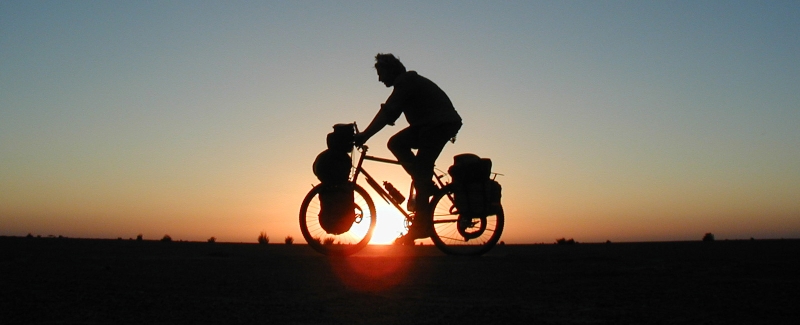 When I watch videos of around the World cyclist ‘Alastair Humphreys’ (shown left) and the like, they’re so
inspirational, they make me want to have my own ‘once in a lifetime experience’. Though, cycling week
after week, and month after month through different countries ain’t my style. I’m more into ‘micro
adventures’ (as Humphreys puts it), but that doesn’t stop me having several different lifetime experiences
(just smaller ones). This adventure starts by riding along one of the most iconic cycling routes in
Europe; the Danube River. Once a long-standing frontier of the Roman Empire, the Danube passes through ten countries
from the river's source in Germany, flowing 1,800 miles to the Black Sea, and I can't wait to ride just over
10% of it. The most popular route starts from just inside the German border at Passau, and terminates in Vienna
Austria, over 200 miles of cycling, after which I catch the train to Budapest for a further few days chilling.
When I watch videos of around the World cyclist ‘Alastair Humphreys’ (shown left) and the like, they’re so
inspirational, they make me want to have my own ‘once in a lifetime experience’. Though, cycling week
after week, and month after month through different countries ain’t my style. I’m more into ‘micro
adventures’ (as Humphreys puts it), but that doesn’t stop me having several different lifetime experiences
(just smaller ones). This adventure starts by riding along one of the most iconic cycling routes in
Europe; the Danube River. Once a long-standing frontier of the Roman Empire, the Danube passes through ten countries
from the river's source in Germany, flowing 1,800 miles to the Black Sea, and I can't wait to ride just over
10% of it. The most popular route starts from just inside the German border at Passau, and terminates in Vienna
Austria, over 200 miles of cycling, after which I catch the train to Budapest for a further few days chilling.
Day 1- Newport- London- Brussels- Cologne (Train)
It was going to be a long day, leaving my house at 0500 to get to London for 0730, the Eurostar™ was
leaving St Pancras at 1030. Once my overground train terminated at Paddington, I ventured down into the
London underground, and arrived at St Pancras into a maze of subterranean tunnels which used to store beer
produced by Burton Brewers. Now, boutique retailers and high street brands fill the brick arches in
the beautifully restored station. Emerging from the sunken mall of fancy shops you see the famous
wrought iron arched roof of the station as it floods in the light. Built in 1867, it was the largest
single spanned roof in  the world, and its design was copied across the globe, including the Grand Central Station
in New York. The Eurostar™ trains are on the level above, I walked up the stairs and headed outside to
catch a glimpse of the grandest frontage of any British railway station; a towering neo-Gothic giant built
with red brick and coloured stone. Now for breakfast in the old booking office; inside was almost cathedral
like with red and white bricked arches, supporting a dark wood ceiling. Breakfast was £29. Well,
foolhardy or money to burn, l tried it. Needless to say it was good, but £29, no way.
the world, and its design was copied across the globe, including the Grand Central Station
in New York. The Eurostar™ trains are on the level above, I walked up the stairs and headed outside to
catch a glimpse of the grandest frontage of any British railway station; a towering neo-Gothic giant built
with red brick and coloured stone. Now for breakfast in the old booking office; inside was almost cathedral
like with red and white bricked arches, supporting a dark wood ceiling. Breakfast was £29. Well,
foolhardy or money to burn, l tried it. Needless to say it was good, but £29, no way.
Once the exorbitant breakfast was out of the way, it was time to checkin, as in any International trip,
it had all the elements of airport security, but we left on the dot. The
speed of the eurostar is incredible; 186 mph (which reduces to 100mph in the tunnel), it’s like flying
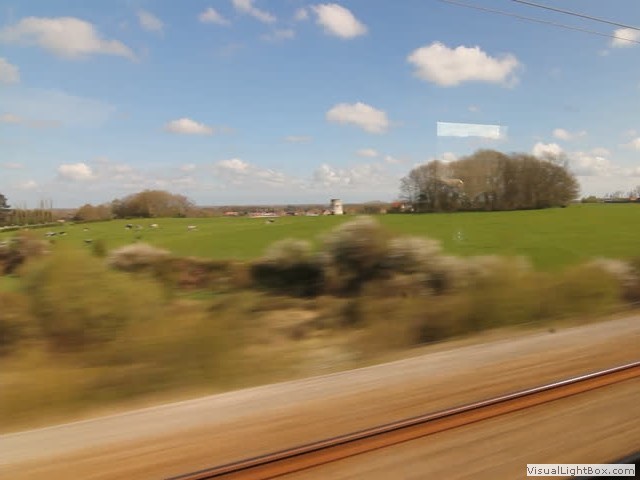 10 feet off the ground, the scenery whizzes past in a blur. We soon arrived in Lille (France), a dirty concrete
underground station, where everybody was scuttling around for their next connection. I was going to Brussels
for my next train, and what a modern station it was. Here, I jumped on an ‘ICE’ train to Cologne, the German
trains knock spots off ours; they’re cleaner, faster, more spacious, and comfortable. I arrived in Cologne
around 1700, but an hour late (there was an accident on the line ahead). First impressions of the City; it stinks of piss,
dirty and full of down and outs outside the station. I headed for the backpackers hostel 200 yards from
the station, on arrival you might be surprised to hear that they spoke to me in a foreign tongue, but they
soon corrected themselves and spoke the Queens English (in fact they spoke very good English). The
backpacker’s hostel is cheap, clean, and central; the rooms are functional, but without flare.
10 feet off the ground, the scenery whizzes past in a blur. We soon arrived in Lille (France), a dirty concrete
underground station, where everybody was scuttling around for their next connection. I was going to Brussels
for my next train, and what a modern station it was. Here, I jumped on an ‘ICE’ train to Cologne, the German
trains knock spots off ours; they’re cleaner, faster, more spacious, and comfortable. I arrived in Cologne
around 1700, but an hour late (there was an accident on the line ahead). First impressions of the City; it stinks of piss,
dirty and full of down and outs outside the station. I headed for the backpackers hostel 200 yards from
the station, on arrival you might be surprised to hear that they spoke to me in a foreign tongue, but they
soon corrected themselves and spoke the Queens English (in fact they spoke very good English). The
backpacker’s hostel is cheap, clean, and central; the rooms are functional, but without flare.
I went for food nearby in a Greek/German restaurant called Brücken. The atmosphere was authentic with a Greek-German kitchen; the spiced lamb skewers were delicate and harmonious, with a terrific mushroom source; very tasty good food, and cheap. Sitting in the restaurant, looking down a street, I had a snapshot of the river Rhine, a commercial barge started to float past. I looked down and continued eating my food, after what seemed an age, I looked back up and the same barge was still sailing past; these ships are incredibly massive.
Day 2- Cologne- Passau (Train)
 I didn’t have an opportunity to visit the cathedral before my journey continued, but even from
the station; Yep, spectacular, the allies obviously missed this, and I'm glad they did, as there’s no way this
intricate and ornate minster could have been recreated, it simply would’ve cost too much deutschmark.
My next ICE train left at 1100, and changed at Frankfurt, it’s easy to use the German trains, the
signage is very good and they even announce the trains in English too.
I didn’t have an opportunity to visit the cathedral before my journey continued, but even from
the station; Yep, spectacular, the allies obviously missed this, and I'm glad they did, as there’s no way this
intricate and ornate minster could have been recreated, it simply would’ve cost too much deutschmark.
My next ICE train left at 1100, and changed at Frankfurt, it’s easy to use the German trains, the
signage is very good and they even announce the trains in English too.
I was heading for Passau, also known as the 'Dreiflüssestadt' or ‘City of three rivers,’ because the Danube is joined at Passau by the Inn from the south and the Ilz from the north. The train was 30 minutes late arriving at Passau; I left the station with enthusiasm to get to my hotel. Much to my surprise; there was a Woolworths in the street (they folded in the UK years ago), I toddled on to the river where there was a multitude of strawberry roofed buildings painted in pastel shades, the Danube was not so much blue (as in Straus) but brown. My hotel was the Hotel Residenz, an absolute gem of a hotel, I hurried in to see if my bike had been delivered. It was there and apart from the disc’s being a little warped, it was in one piece. After putting it together, I went for a stroll (more of a hike really) up a damp winding cliff path to the castle and restaurant (which was closed) perched on a precipice overlooking the whole town. Carefully I retraced my steps back down the path, the river banks were strewn with massive elongated cruise boats; empty now (it must be off season), in fact there wasn’t many people around at all, not that it was deserted, just quiet.
Day 3- Passau to Untermühl (39 miles)
This was the first day cycling, and after a fantastic breakfast, I had a chat with the manager about
transporting the empty bike bag onto Vienna, then left around 0930. The weather was just on the side of chilly,
but the sun was shining. After crossing the 'Schanzl' bridge I began the trip on the northern side of the Danube
heading east. It followed the main road at first, but then it was soon on car free roads which led into
dedicated cycle paths. The river was full to the brim and looked to me near overflowing, hemmed
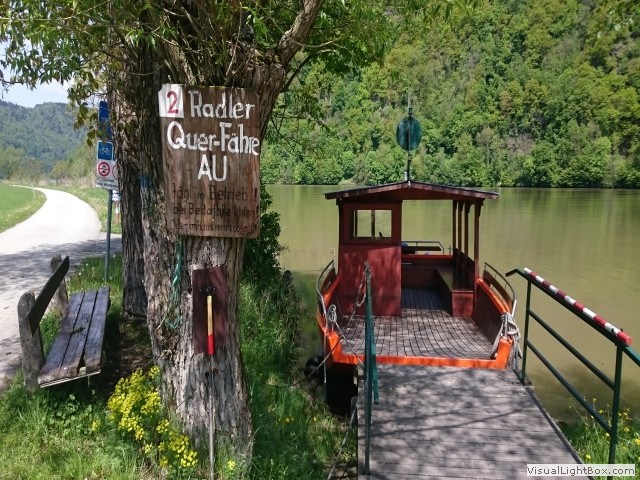 in by steep sided luscious green forests, you couldn’t see the cycle path continuing, but just enough
appeared in front to continue riding. I passed two small ferries moored against the river bank opposite Schlogen,
one man shouted something to me, but I didn’t understand, if they can’t speak English
then I’m jolly well going to ignore them, so I continued on. Only to come to the end of the cycle track,
I retraced my steps to the ferry. “Is not possible to go that way”, the ferryman said. Why the fop didn’t
he say that in the first place? In fact it’s me that is ignorant, I can’t speak German, but
they speak fantastic English. Two euro’s later and I was on the Radfahre (cycle) ferry cruising to the
south side of the river.
in by steep sided luscious green forests, you couldn’t see the cycle path continuing, but just enough
appeared in front to continue riding. I passed two small ferries moored against the river bank opposite Schlogen,
one man shouted something to me, but I didn’t understand, if they can’t speak English
then I’m jolly well going to ignore them, so I continued on. Only to come to the end of the cycle track,
I retraced my steps to the ferry. “Is not possible to go that way”, the ferryman said. Why the fop didn’t
he say that in the first place? In fact it’s me that is ignorant, I can’t speak German, but
they speak fantastic English. Two euro’s later and I was on the Radfahre (cycle) ferry cruising to the
south side of the river.
When planning the trip, there was no clear information which side of the Danube was best to ride on and I had to cross the river again a few miles further on (as my hotel was on the other side). The smell of coffee signals the brain that caffeine is on the way and there’s plenty of places to stop for a cup of Joe, combined with the sticky scent of Canadian poplar trees floating in the air it certainly releases the endorphins, and I could be the only person on the planet right now, such is the enchantment of this place. On the other side of the coin, riding along, I didn’t pass many cyclists, but the ones I did, seemed miserable, it seems most Austrian's (or German’s) can’t smile or say hello, much is the same in the UK in cities I suppose. The lush green canopies continued, climbing almost vertical away from the Danube, waterfalls streamed across the path, and birds sang their hearts out. I first saw my hotel across a wide sweeping bend in the river, what an idealic place this was, swans gracefully paddled along, but I’d never heard the sound they make when taking off. They run along the water and the wing tips make a high pitch noise as they touch the water. The hotel was quiet except for the locals enjoying a beer, but later that night more people began to arrive. It seems this was a popular place, and I can see why; the sunset through the valley of green was immense, changing the water from a crucible of gold to saffron-yellow, to light blue then dark blue to black. A great day, very enjoyable.
Day 4- Untermühl to Au an der Donau (49 miles)
No more than ½ a mile from the hotel, I came across a sign ‘Kein Radfahren‘ with the
familier red strike through a cycle; No cycling. The path had stopped again, with instructions to
cross over with a ferry, I boarded the third ferry in two days cycling, and crossed over to the lower
Austrian side. A few miles later the valley flattened out and became quite industrialised, I realised
I was riding between two stretches of water, on the left of me was the Danube and on the right was
the small Aschach river. The flies and mozzies (some as big as a small dog) were roaming in
swarms, I had to ride with my hand pinching my nose and mouth shut except to gingerly inhale, which wasn’t pleasant,
thankfully the flies subsided as the miles rolled on. I passed another hydroeletric plant
damming the river and although ‘Mr Garrmin‘ said I could ride across it, I couldnt find the
path so I continued on the side I was on.
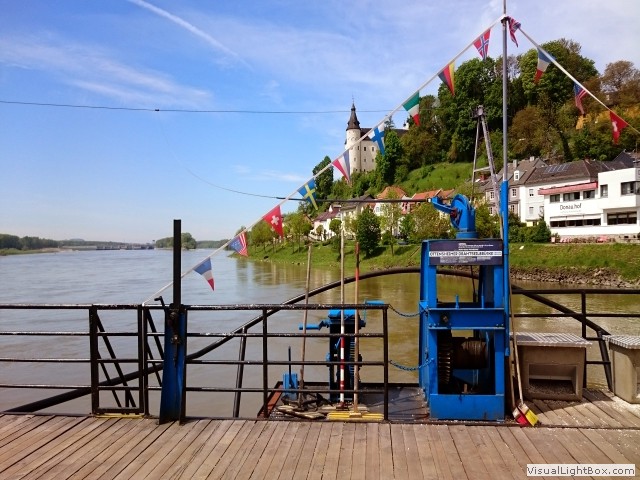 The path directs you off the main
road and onto a smaller lane going through a dense wood, I’d lost sense of the river, but then I
could see Ottensheim Castle on the far bank. The ferry slipway appeared out of nowhere, and I studied
a steel cable high across the river and wondered how did it tow the ferry across? As the ferry glided
across, I could hear it was engineless and came across using the the power of the Danube current alone. I
crossed into Ottensheim another sleepy Barvarian village, and had a well deserved coffee, then
pushed on through Puchenau.
The path directs you off the main
road and onto a smaller lane going through a dense wood, I’d lost sense of the river, but then I
could see Ottensheim Castle on the far bank. The ferry slipway appeared out of nowhere, and I studied
a steel cable high across the river and wondered how did it tow the ferry across? As the ferry glided
across, I could hear it was engineless and came across using the the power of the Danube current alone. I
crossed into Ottensheim another sleepy Barvarian village, and had a well deserved coffee, then
pushed on through Puchenau.
It was now baking hot, and even the river looked like a semi-molten mirror. I stopped in a cafe near the riverside at Linz (Hitlers birth place), and sat under a big tree for shade. When it was time to move on, I prized my shorts from the seat and began again. The riverside tarmac stopped and changed to a bumpy rocky path, somehow I’d gone wrong. I know the ‘R1‘ turned left a while back, but my Garmin told me to go straight on. For a short while I continued on this teeth rattling path (it’s funny, in the UK, I would have been happy just to be off the main roads, even on this uncomfortable trail), then I saw cyclists far to the left, that had to be the route. After crossing a field of nodding daisies, I was on what looked like an old railway track, smooth with tarmac (it was only later I discovered it was an old German WW2 railway track). After a mile or two I was following the Danube again, and I think I was slowly melting, but just past an old railway bridge the wind changed to a headwind, giving me a welcome air conditioned affect.
 Suddenly I was off route again, I needed to turn left away from the Danube following Route 1, back
to the extreme heat bouncing off the road. I went through Stacherlsiedlung then Gussen (which
had a railway to a former concentration camp) I passed the SS guard´s building for the KZ Gusen
I Concentration Camp and rode through to 'Weinergraben' to 'Lager Mauthausen' where there was a memorial museum of the camp.
Like all other WWII tributes and museums, it speaks of the horrific conditions of POWs and the
tragedies done to the Jewish population, however unlike other places, it keeps intact moments of
history exactly how it was and allows you to imagine the appalling conditions the inmates
endured. There’s a poignant oversize sculpture of some barbed wire, I left with a tear in my eye.
It was back to the river at Mauthausen passing a pretty village on the banks of the Danube, then
inland again. By the time I reached Pension Au an der Donau (a camp site on the Danube with
backpacking rooms), I was drained and burnt to a crisp. I stripped off in my room and had the typical
cyclists markings; ¾ red arms, ¾ red legs, a red neck, and red stripes on my
head where my helmet sat. Today was hard work; the combination of the heat (27ºC), and wrong
turns had made the day a bitch, thoughts of the concentration camp made me sad, but I
was glad I took the time to see it.
Suddenly I was off route again, I needed to turn left away from the Danube following Route 1, back
to the extreme heat bouncing off the road. I went through Stacherlsiedlung then Gussen (which
had a railway to a former concentration camp) I passed the SS guard´s building for the KZ Gusen
I Concentration Camp and rode through to 'Weinergraben' to 'Lager Mauthausen' where there was a memorial museum of the camp.
Like all other WWII tributes and museums, it speaks of the horrific conditions of POWs and the
tragedies done to the Jewish population, however unlike other places, it keeps intact moments of
history exactly how it was and allows you to imagine the appalling conditions the inmates
endured. There’s a poignant oversize sculpture of some barbed wire, I left with a tear in my eye.
It was back to the river at Mauthausen passing a pretty village on the banks of the Danube, then
inland again. By the time I reached Pension Au an der Donau (a camp site on the Danube with
backpacking rooms), I was drained and burnt to a crisp. I stripped off in my room and had the typical
cyclists markings; ¾ red arms, ¾ red legs, a red neck, and red stripes on my
head where my helmet sat. Today was hard work; the combination of the heat (27ºC), and wrong
turns had made the day a bitch, thoughts of the concentration camp made me sad, but I
was glad I took the time to see it.
Day 5- Au an der Donau to Emmersdorf an der Donau (48 miles)
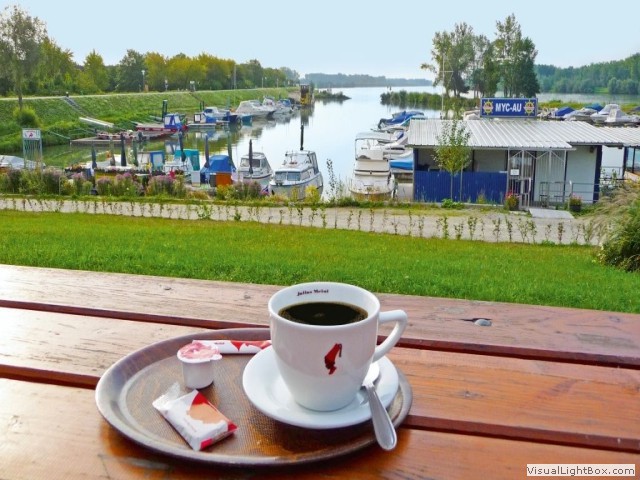 With the snow capped Alps in the background (the image didn't capture it), I sat down to a
typical breakfast of more pig products (and bread), the Austrians ♥ pig, their
diet is built on the back of it, and they sneak it into everything, every meal. I began the
day in shorts again; with sun block on how much more could I burn? Within a few miles I came
across Schleuse Wallsee-Mitterkirchen (loosely translated means sluice), another hydroelectric
power plant that spans the river, only this one is in the history books. You
can also see the castle at Wallsee from here, built in the late nineteenth century and still owned
by a private family. Along the river there isn’t any shortage of castles as I pass the next one on
my side; Schloss Dornach and then at Grein there was another; Schloss Greinburg. At Grein there was another
ferry and crowds of cyclists boarded it to cross to the other side, however I continued on my side and quite
frankly; I wish I had crossed with the others. The next section on the north side of the river was
on the road, some of it had a two foot wide segregated section separated from traffic with white lines, but as
it continued even this disappeared. The road was busy with heavy lorries, but to be fair; they
were excellent and waited until there was safely enough room to pass. I was quite envious of the people cycling
on the other side, as it looked safer and more tranquil. The dangerous path continued for a few
miles until reaching Hirschenau, where the cycle path came off the road onto a side road. I soon
passed Schloss Persenbeug (you’ve guessed by now that ‘Schloss’ means castle) which was right next to another
hydro electric dam and rode into the sleepy village of Persenbeug. Here I had a great chocolate
ice-cream and coffee and sheltered from the blazing sun.
With the snow capped Alps in the background (the image didn't capture it), I sat down to a
typical breakfast of more pig products (and bread), the Austrians ♥ pig, their
diet is built on the back of it, and they sneak it into everything, every meal. I began the
day in shorts again; with sun block on how much more could I burn? Within a few miles I came
across Schleuse Wallsee-Mitterkirchen (loosely translated means sluice), another hydroelectric
power plant that spans the river, only this one is in the history books. You
can also see the castle at Wallsee from here, built in the late nineteenth century and still owned
by a private family. Along the river there isn’t any shortage of castles as I pass the next one on
my side; Schloss Dornach and then at Grein there was another; Schloss Greinburg. At Grein there was another
ferry and crowds of cyclists boarded it to cross to the other side, however I continued on my side and quite
frankly; I wish I had crossed with the others. The next section on the north side of the river was
on the road, some of it had a two foot wide segregated section separated from traffic with white lines, but as
it continued even this disappeared. The road was busy with heavy lorries, but to be fair; they
were excellent and waited until there was safely enough room to pass. I was quite envious of the people cycling
on the other side, as it looked safer and more tranquil. The dangerous path continued for a few
miles until reaching Hirschenau, where the cycle path came off the road onto a side road. I soon
passed Schloss Persenbeug (you’ve guessed by now that ‘Schloss’ means castle) which was right next to another
hydro electric dam and rode into the sleepy village of Persenbeug. Here I had a great chocolate
ice-cream and coffee and sheltered from the blazing sun.
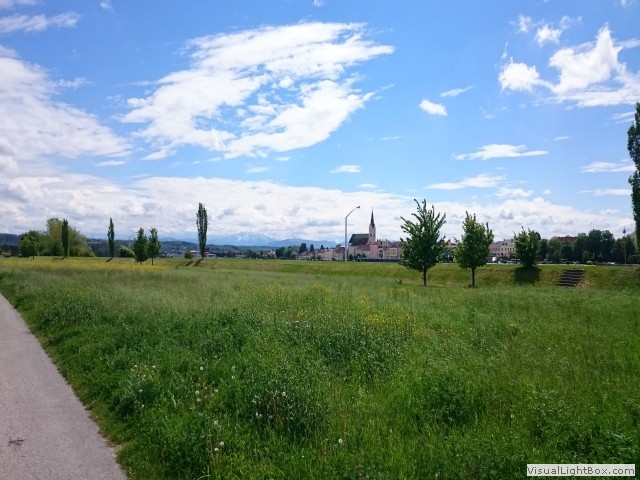 Route 3 continued straight, but again I followed the ‘Garmin’ onto flat country lanes, open
and exposed, the sun beated down, and the heat was so intense I could’ve fried an egg on my head. I did
capture an envious distant image of the snow capped mountains of the Alps, but apart from that it was a monotonous
ride to Metzling where I rejoined the Danube. At Marbach an der Donau my polar heart rate
transmitter gave out, conveniently next to a cycle shop, I went in, but the mechanic said he couldn’t
change it for 15 minutes, so I had another brew in café Lechner and a slice of something very
sweet and beautiful. It was here I learnt another thing about Austrians; around 3 o'clock is ‘kafee
& Kuchen’ (coffee and cake) time, and everything stops, so if you want something done at
this time- tough shit. With the battery changed, I continued, the cycle path is built on the
dike (correct spelling I think) protecting the villages from flooding. The issue is- it doesn’t
really work, so the authorities are building a concrete wall two meters high (which is
extendable up) on top of the dike, the upshot of this is the cycle path is closed and its
back on the road again. At Weitenegg I left the river and went around a lake, through Luberegg
and back on the Danube path. The end was near, I could sense it, without realising it I was doing
20 mph on the flat (I haven’t done that speed on the flat for years), until I reached the hotel
Emmersdorf an der Donau. Emmersdorf an der Donau is a pretty, narrow streeted medieval village,
where it looks like the massive river cruise boats stop off, but because of the flood prevention
works, they now bypass the town. This leg of the journey was meant to be 43 miles, but was
actually 48 miles, I was haggard and barbecued, and coming to the conclusion that maybe the
south side the river is better.
Route 3 continued straight, but again I followed the ‘Garmin’ onto flat country lanes, open
and exposed, the sun beated down, and the heat was so intense I could’ve fried an egg on my head. I did
capture an envious distant image of the snow capped mountains of the Alps, but apart from that it was a monotonous
ride to Metzling where I rejoined the Danube. At Marbach an der Donau my polar heart rate
transmitter gave out, conveniently next to a cycle shop, I went in, but the mechanic said he couldn’t
change it for 15 minutes, so I had another brew in café Lechner and a slice of something very
sweet and beautiful. It was here I learnt another thing about Austrians; around 3 o'clock is ‘kafee
& Kuchen’ (coffee and cake) time, and everything stops, so if you want something done at
this time- tough shit. With the battery changed, I continued, the cycle path is built on the
dike (correct spelling I think) protecting the villages from flooding. The issue is- it doesn’t
really work, so the authorities are building a concrete wall two meters high (which is
extendable up) on top of the dike, the upshot of this is the cycle path is closed and its
back on the road again. At Weitenegg I left the river and went around a lake, through Luberegg
and back on the Danube path. The end was near, I could sense it, without realising it I was doing
20 mph on the flat (I haven’t done that speed on the flat for years), until I reached the hotel
Emmersdorf an der Donau. Emmersdorf an der Donau is a pretty, narrow streeted medieval village,
where it looks like the massive river cruise boats stop off, but because of the flood prevention
works, they now bypass the town. This leg of the journey was meant to be 43 miles, but was
actually 48 miles, I was haggard and barbecued, and coming to the conclusion that maybe the
south side the river is better.
Day 6- Emmersdorf an der Donau to Tulln (50 miles but 25 miles by train)
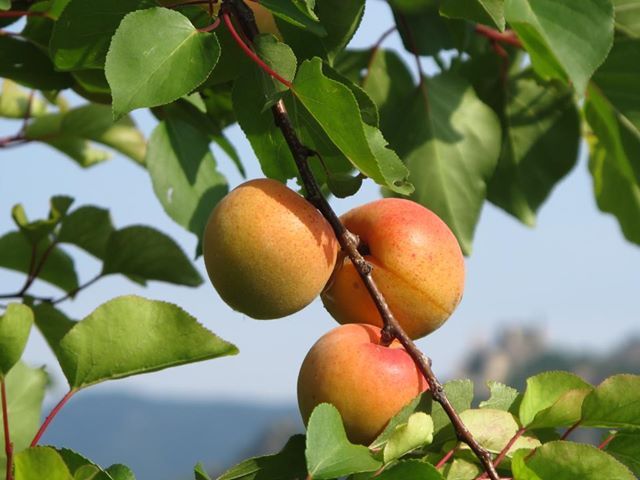 Starting from Emmersdorf, the sky was overcast and humid, and they predicted heavy showers
today. I was heading for the Wachau valley, a famous wine growing region, along a stretch of the
river that is reputed to be very pretty. Nestled next to the fields of old vines are rows of apricots, they transform
them into everything from fruit punches to apricot brandy. I tasted some in a roadside
cabin, very sweet, in fact a little too sweet for me (and that's saying something). On the recommendation of my previous hotel, I
followed Route six which diverted me away from the river, but the Danube is hardly ever out of sight,
as the signs send me through all these little towns. The first town on route is the unassuming little market
town of Spitz, it's very touristy, with dozens of wooden pointing signs on each corner, highlighting who knows
what. Spitz is a maze of cobbled streets, I zigzagged through hoards of cycle tourists (all with the same tee
shirts on, naming their particular tour) coming the other way and stopped off at hotel Mariandl Wachau for a coffee
and watched amazed at the waiters serving food across the road from the hotel, dodging the cyclists
as they crossed, keeping the food and drink on the sliver trays with one hand underneath.
Starting from Emmersdorf, the sky was overcast and humid, and they predicted heavy showers
today. I was heading for the Wachau valley, a famous wine growing region, along a stretch of the
river that is reputed to be very pretty. Nestled next to the fields of old vines are rows of apricots, they transform
them into everything from fruit punches to apricot brandy. I tasted some in a roadside
cabin, very sweet, in fact a little too sweet for me (and that's saying something). On the recommendation of my previous hotel, I
followed Route six which diverted me away from the river, but the Danube is hardly ever out of sight,
as the signs send me through all these little towns. The first town on route is the unassuming little market
town of Spitz, it's very touristy, with dozens of wooden pointing signs on each corner, highlighting who knows
what. Spitz is a maze of cobbled streets, I zigzagged through hoards of cycle tourists (all with the same tee
shirts on, naming their particular tour) coming the other way and stopped off at hotel Mariandl Wachau for a coffee
and watched amazed at the waiters serving food across the road from the hotel, dodging the cyclists
as they crossed, keeping the food and drink on the sliver trays with one hand underneath.
Flat, it isn’t, it undulates very gently through narrow streeted medieval villages, each with their own cafe, church, and hotel. This is the busiest I’ve seen the cycle route, most cyclists are opposing me, and I notice there is an abundance of old people bussing around on electric bikes. I was suffering today on several fronts- any historical fracture will come back to haunt the body (and I’ve no shortage of them), but my nemesis is my right foot, it felt like it had a javelin through it, likely to be Morton’s neuroma. Then there was the increase in roughage and sharp nuts in the breakfast cereals, which had taken its toll, hurting me where the sun doesn’t shine (there’s some good stuff in the UK that contains lignocaine in a zinc oxide cream, it's good for saddle chaf too). I made more frequent stops and took my shoes off, but it only gave short respite.
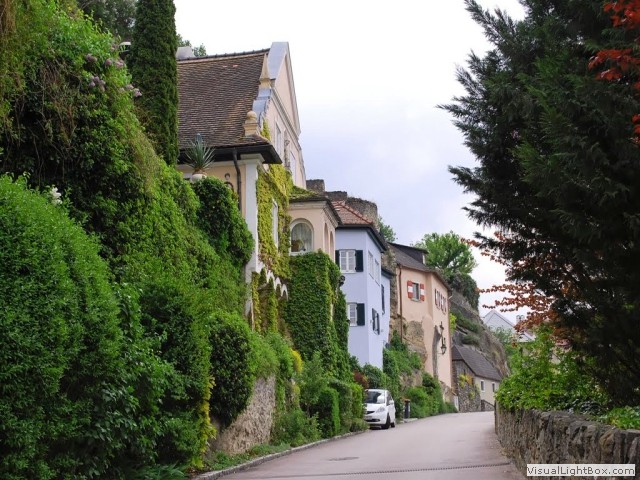 I climbed up a short steep hill into Durnstein, past rows of pastel coloured houses and left the
Danube meandering below, on the top was the most frequently visited village in the area, full of
little shops selling variants of apricot liquor with an abandoned castle way off to the top of the hill
called Burgruine. I battled my way through crowds on the narrow cobbled high street, passing the ‘Stift Dürnstein’
monastery to come out the other side with a ‘eureka’ moment; I will catch the train to my next stop. The
next major rail station was Krems, a mere 5 miles away, I pushed on the pedals trying to put all of the power
through the left pedal, I felt like a wounded animal limping away from the town.
I climbed up a short steep hill into Durnstein, past rows of pastel coloured houses and left the
Danube meandering below, on the top was the most frequently visited village in the area, full of
little shops selling variants of apricot liquor with an abandoned castle way off to the top of the hill
called Burgruine. I battled my way through crowds on the narrow cobbled high street, passing the ‘Stift Dürnstein’
monastery to come out the other side with a ‘eureka’ moment; I will catch the train to my next stop. The
next major rail station was Krems, a mere 5 miles away, I pushed on the pedals trying to put all of the power
through the left pedal, I felt like a wounded animal limping away from the town.
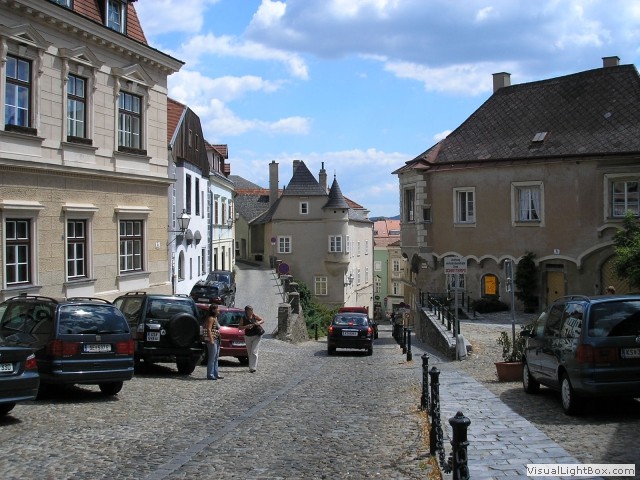 Krems is one of the oldest cities in Austria; the first documented reference to it dates to 995, and there’s
a millennium of history at every step. Hot, sweaty, and in pain, I limped into the station pushing my bike,
only to be shouted at by someone (which I didn’t react to), I went into the ticket office, this time I was shouted at by the
person behind the counter. “I'm sorry, I don’t speak Austrian”, I said. “No cycles inside the
building! Take it outside”, the man behind the counter barked in English. Well, as I had my passport,
money, iPad, phone, and all my belongings attached to the bike, I was in no mood for this
bureaucratic, officious treatment; I refused. After a few minutes of walking around in small circles
strutting like a pigeon, the man finally gave me a ticket to Tulln. I noticed bikes are not even allowed
in the lifts, you have to use a ramp on the stairs (easy for normal cycles, but hard work for me laden
with panniers and lame like I’d been shot in the foot).
Krems is one of the oldest cities in Austria; the first documented reference to it dates to 995, and there’s
a millennium of history at every step. Hot, sweaty, and in pain, I limped into the station pushing my bike,
only to be shouted at by someone (which I didn’t react to), I went into the ticket office, this time I was shouted at by the
person behind the counter. “I'm sorry, I don’t speak Austrian”, I said. “No cycles inside the
building! Take it outside”, the man behind the counter barked in English. Well, as I had my passport,
money, iPad, phone, and all my belongings attached to the bike, I was in no mood for this
bureaucratic, officious treatment; I refused. After a few minutes of walking around in small circles
strutting like a pigeon, the man finally gave me a ticket to Tulln. I noticed bikes are not even allowed
in the lifts, you have to use a ramp on the stairs (easy for normal cycles, but hard work for me laden
with panniers and lame like I’d been shot in the foot).
The Austrian double decker City trains are impressive, with enough room for loads of bikes. It looked like I’d I caught the train just in time, the rain battered the windows leaving horizontal streams of water on the windows. I arrived at Tulln and made my way to the hotel, a modest basic hotel. After some pain killers and a good meal, I went for a walk and came across a local tennis club. Inside I could hear people cheering, I went in to find a local women’s double match playing. I’ve never seen a live competitive tennis match before, it was amazing how much spin they were applying and how fast the shots were, it was brilliant.
Day 7- Tulln to Vienna (23 miles)
A new day- and a new arse, the haemorrhoids and foot pain were history. I had my breakfast consisting of more pig products and set off for Vienna on a boiling hot day. The banks of the Danube were a stone’s throw away, with the end in sight and with all the miles behind me- today was going to be a doddle. No sooner had I set off, when I came across a strange fountain and statues. The Nibelungen Brunnen monument is a composition of the scene "encounter of Kriemhild", and is seen as a cultural encounter between the East and the West (what ever that means).
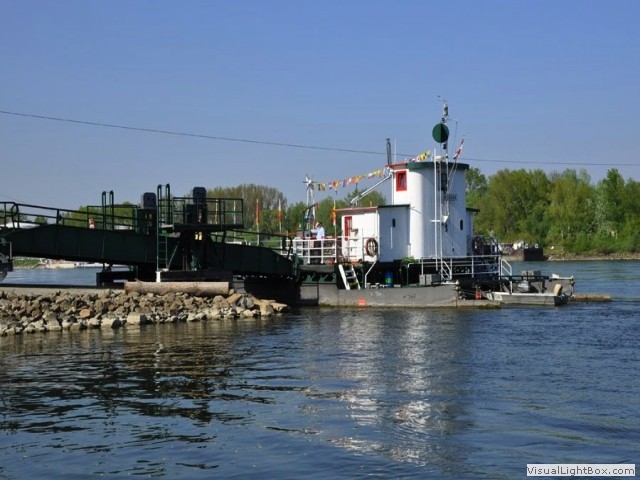 Later I rode across a barrage crossing the lake 'Donaualtarm Greifenstein'. There was a park attached to
the lake where I had a nice coffee. After a few miles I turned inland and lost sight of the Danube, following
lefts and rights in a residential area, I finally arrived back at the Danube and near another ferry,
which worked the same way as the Ottensheim ferry using a high level steel rope to ferry glide across the river. I left
herds of cyclists back where I turned off, and somehow I thought they knew more than me as the path suddenly
stopped and turned into a rocky lane- unridable. I could see the massive buildings in the City, towering in the skyline, I
was so near Vienna I could smell it. I retraced my steps and went back to the proper cycle path. Then my Garmin took
me back along the river and across some railway tracks, through a deprived area with a large number of shanty
dwellings and the compulsory graffiti everywhere. You could say 'I was on the wrong side of the tracks'. I passed
through a break in the flood defence wall and came out where there were loads of massive river cruisers, with people boarding
coaches going on their excursions leaving their luxury liners and the brilliant white table clothes in the
glass sided restaurants behind. Its surreal, there’s so much poverty on the one side of a wall and opulence on the other.
Later I rode across a barrage crossing the lake 'Donaualtarm Greifenstein'. There was a park attached to
the lake where I had a nice coffee. After a few miles I turned inland and lost sight of the Danube, following
lefts and rights in a residential area, I finally arrived back at the Danube and near another ferry,
which worked the same way as the Ottensheim ferry using a high level steel rope to ferry glide across the river. I left
herds of cyclists back where I turned off, and somehow I thought they knew more than me as the path suddenly
stopped and turned into a rocky lane- unridable. I could see the massive buildings in the City, towering in the skyline, I
was so near Vienna I could smell it. I retraced my steps and went back to the proper cycle path. Then my Garmin took
me back along the river and across some railway tracks, through a deprived area with a large number of shanty
dwellings and the compulsory graffiti everywhere. You could say 'I was on the wrong side of the tracks'. I passed
through a break in the flood defence wall and came out where there were loads of massive river cruisers, with people boarding
coaches going on their excursions leaving their luxury liners and the brilliant white table clothes in the
glass sided restaurants behind. Its surreal, there’s so much poverty on the one side of a wall and opulence on the other.
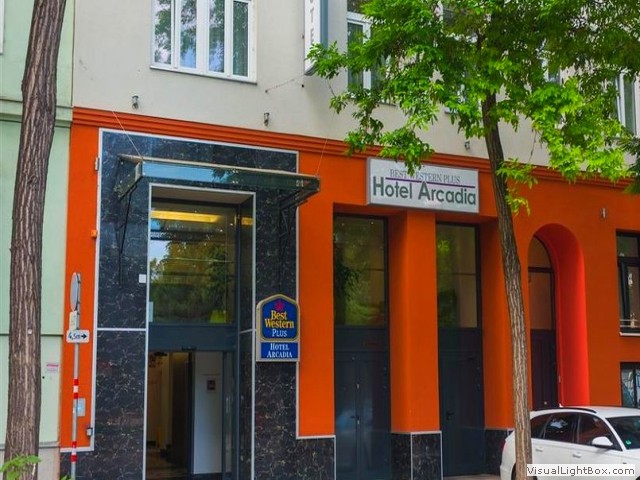 I reached the hotel and was quite disappointed by the frontage even before I walked through the door; I was
expecting a big swish hotel. I walked into a pokey little reception, squeezed in-between the stairs
and the breakfast room, I’d expected more from a 'Best Western'. I booked in and asked about my bike bag (which
was sent from Passau), it hadn’t arrived, though it was supposed to be there two days earlier, they were
less than helpfull about it- "You'll have to wait until Monday to sort it out". Then I asked what
entertainment was on tonight in Vienna (I fancied something musical), I was told by the receptionist
“you’ll have to look on Google”. ‘Cheers, I didnt think of that, thanks’. The staff's attitude matched the diminutive
hotel facia, they couldn’t care less. I went up to the room which had no views and was quite small, but in
fairness the room was immaculate, absolutely spotless. Welcome to Vienna.
I reached the hotel and was quite disappointed by the frontage even before I walked through the door; I was
expecting a big swish hotel. I walked into a pokey little reception, squeezed in-between the stairs
and the breakfast room, I’d expected more from a 'Best Western'. I booked in and asked about my bike bag (which
was sent from Passau), it hadn’t arrived, though it was supposed to be there two days earlier, they were
less than helpfull about it- "You'll have to wait until Monday to sort it out". Then I asked what
entertainment was on tonight in Vienna (I fancied something musical), I was told by the receptionist
“you’ll have to look on Google”. ‘Cheers, I didnt think of that, thanks’. The staff's attitude matched the diminutive
hotel facia, they couldn’t care less. I went up to the room which had no views and was quite small, but in
fairness the room was immaculate, absolutely spotless. Welcome to Vienna.
Day 8- Tour around Vienna (10 miles)
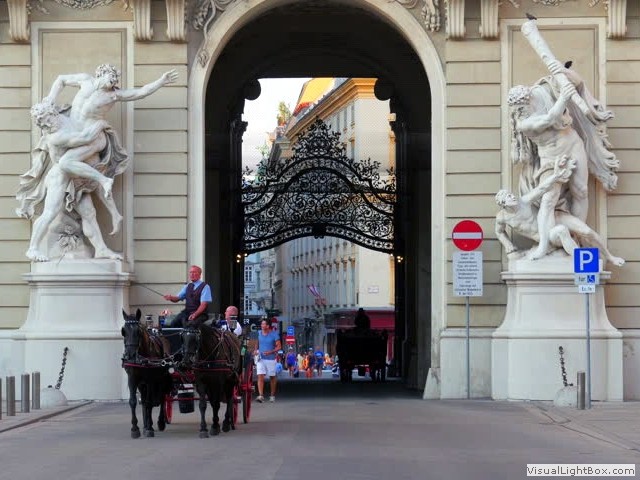 This is not my first time in Vienna, fond memories are what brought me back to this enchanting
city. Like most cities, the buildings are made of sandstone, the problem with this material, is
it goes black in time- not so with Vienna, most buildings are pristine, it’s an incredible clean
city. Without doubt Vienna is alluring; it’s teeming with stunningly beautiful architecture
and gorgeous parks, jam-packed with remarkable museums and palaces. There’s so much history on every
street corner it will leave anybody in awe. Apart from being regarded as the ‘City of Music’ because
of its musical legacy, Vienna is also said to be ‘The City of Dreams’ because it was home to the
World's first psycho-analyst; Sigmund Freud.
This is not my first time in Vienna, fond memories are what brought me back to this enchanting
city. Like most cities, the buildings are made of sandstone, the problem with this material, is
it goes black in time- not so with Vienna, most buildings are pristine, it’s an incredible clean
city. Without doubt Vienna is alluring; it’s teeming with stunningly beautiful architecture
and gorgeous parks, jam-packed with remarkable museums and palaces. There’s so much history on every
street corner it will leave anybody in awe. Apart from being regarded as the ‘City of Music’ because
of its musical legacy, Vienna is also said to be ‘The City of Dreams’ because it was home to the
World's first psycho-analyst; Sigmund Freud.
Vienna is by far the best cycling friendly City I’ve ever ridden in, cycle paths run
alongside pedestrian paths, and at traffic lights there’s cycle lights too. There’s guided cycle tours
of the city, with or without your own bike, check with the tour guide as they can supply bikes or
use a ‘Citybike’ if you haven't got your own. Citybike launched in 2003 as a public bike rental system that allows
everyone to move around by bike at low cost. 1,500 bikes are currently available at 121
locations throughout the city. There is a one-time registration for the use of Citybike. You
can do it at a bike station, online, or dedicated app and it’s cheap at a few €’s an hour.

Vienna negatives
Beware, Vienna is Austria's bike theft capital with an average of 25 bicycles stolen every day. In 2013 police registered 9,386 bike thefts, and that number continues to increase annually. Once your bike has been stolen, it’s unlikely you’ll get it back. Police say that they only manage to recover 3.8% of stolen bikes. There's too many tourists- Vienna continues to groan under the weight and destruction caused by mega river cruise ships and millions of tourists every year. With too many tourists comes the selfie sticks, they stop without warning to commune with their friends and take that ultimate shot, which they then have to put on social media straight away- twats.
Vienna ranks as one of the most expensive cities in the world. The cost of accommodation and food is generally more expensive than any other central/eastern European city. Austrians appear to be terribly discourteous, but the Viennese take the biscuit. There is an apathetic and quite often rude approach to customer service; be it the grumpy bus driver, a waiter in a restaurant or the odd old lady behind the counter in a supermarket- be prepared to be moaned at just because you’re there. It’s common practise for public transportation jobsworth’s to target tourists who do not know that once subway tickets have been purchased, they need to be validated by date stamping them in a machine. They charge a 100€ fine for not validating the ticket and stand at locations frequented by visitors.
Day 9/10- Tour around Budapest (6 miles)
 The bike was packed in the bag and I headed by taxi to Vienna train station, as I remember it; the old
station was half a mile north east of the new station. The driver explained that this was now a massive
modern station and indeed it was, but they didn’t have luggage trolleys. An hour late, the OBB train
arrived and was as modern as the station it pulled into. I wrestled the big bike bag on board, fighting
with the crowds boarding as they shoved and pushed to get on as if the train was going to leave without
them, apart from that it was a pleasant journey to Budapest. I arrived at Budapest Keliti railway station
and dragged my suitcase and the bike bag off the train down the uneven platform in baking heat. Keliti
station is a far cry from the swish modern Vienna station, this was definitely ‘east meets west’ even
though Hungary had ceased to be a communist country in 1989, it was clear they just didn’t have the
same money as Vienna. Once inside the terminal, the surface was better and I entered the old ticket
hall, a huge vestibule with a yellow flagstone floor polished by thousands of feet over the years, then
headed outside toward the taxi rank (later when researching this blog I discovered
I’d came out of a side entrance, the main entrance was much grander).
The bike was packed in the bag and I headed by taxi to Vienna train station, as I remember it; the old
station was half a mile north east of the new station. The driver explained that this was now a massive
modern station and indeed it was, but they didn’t have luggage trolleys. An hour late, the OBB train
arrived and was as modern as the station it pulled into. I wrestled the big bike bag on board, fighting
with the crowds boarding as they shoved and pushed to get on as if the train was going to leave without
them, apart from that it was a pleasant journey to Budapest. I arrived at Budapest Keliti railway station
and dragged my suitcase and the bike bag off the train down the uneven platform in baking heat. Keliti
station is a far cry from the swish modern Vienna station, this was definitely ‘east meets west’ even
though Hungary had ceased to be a communist country in 1989, it was clear they just didn’t have the
same money as Vienna. Once inside the terminal, the surface was better and I entered the old ticket
hall, a huge vestibule with a yellow flagstone floor polished by thousands of feet over the years, then
headed outside toward the taxi rank (later when researching this blog I discovered
I’d came out of a side entrance, the main entrance was much grander).
The heat was intense as I haggled with the taxi driver about the price (I already knew how
much I should pay to my hotel) then off we went. Budapest had the same massive buildings as
Vienna, but these were dirty and dishevelled, as the journey continued to the more touristy
areas the buildings became cleaner. I was going to end this trip by staying in a luxury hotel
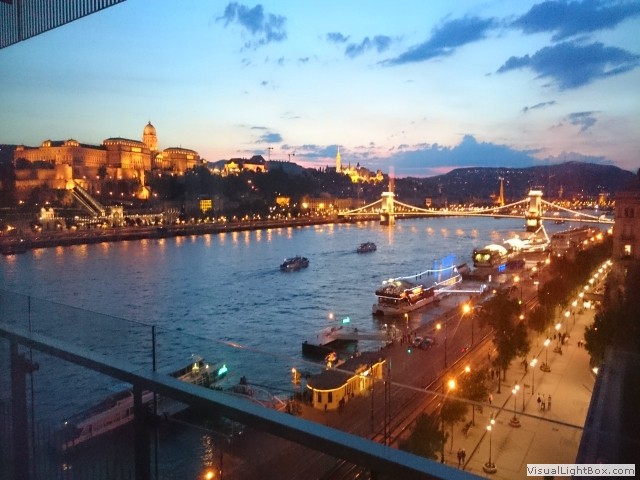 and so booked into the Budapest Marriot with a river view, only the room had an obscured view
of the river. After some postulating with the management of 'how hard done by I thought I was and
how I expected better from a Marriot', they gave me a free upgrade (sometimes it’s worth a little
song and dance), the new room was fantastic. The must see spots aren’t as overwhelming as
Vienna, they’re much more spaced out, but equally
as fascinating. There’s numerous restaurants in the inner city streets from many countries,
Hungarians love food- full fat everything. Cycling around Budapest wasn’t pleasant, for
starters ‘Buda’ is up a hill, and ‘Pest’ is not friendly to cyclists- the drivers are mad
and you can taste the carbon monoxide. Though I understand there are cycle friendly areas
around Lake Velence an hour away, I will have to investigate on another date.
and so booked into the Budapest Marriot with a river view, only the room had an obscured view
of the river. After some postulating with the management of 'how hard done by I thought I was and
how I expected better from a Marriot', they gave me a free upgrade (sometimes it’s worth a little
song and dance), the new room was fantastic. The must see spots aren’t as overwhelming as
Vienna, they’re much more spaced out, but equally
as fascinating. There’s numerous restaurants in the inner city streets from many countries,
Hungarians love food- full fat everything. Cycling around Budapest wasn’t pleasant, for
starters ‘Buda’ is up a hill, and ‘Pest’ is not friendly to cyclists- the drivers are mad
and you can taste the carbon monoxide. Though I understand there are cycle friendly areas
around Lake Velence an hour away, I will have to investigate on another date.
 Budapest does have its own sightseeing cycling tours which boast of cycle lanes and safe routes to the main
attractions (I very much doubt that). I think the ‘Budapest 24hr Card’ which gives you unlimited free access to all
the public transportation for 24hrs and offers discounted access to the top sights, is the better way to see the city.
Budapest does have its own sightseeing cycling tours which boast of cycle lanes and safe routes to the main
attractions (I very much doubt that). I think the ‘Budapest 24hr Card’ which gives you unlimited free access to all
the public transportation for 24hrs and offers discounted access to the top sights, is the better way to see the city.
Budapest negatives
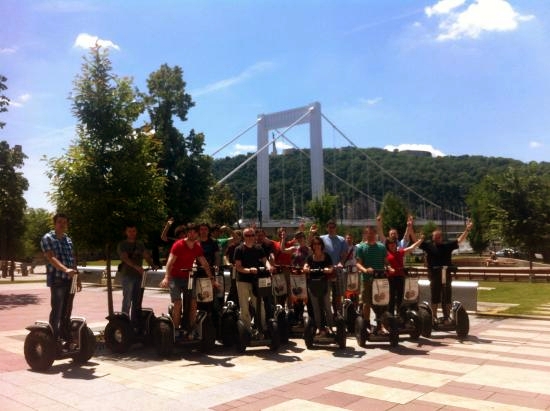 Pálinka fruit brandy, I can’t describe how revolting this stuff is,
but it’s good for cleaning the bike down. Hungarian wine is repulsive (sorry, but that’s my
opinion). Hoards of tourist segways (two wheel stand up electric scooters) roaming the streets,
at least with cycling tours you can hear the people grunting behind you, these segways are
silent, until you hear the lead person say- “excuse me” followed by another ten people saying
the same thing. Of course they could go around you, but most are novices and have enough
trouble staying upright, let alone circumnavigating around a 2mph pedestrian.
Pálinka fruit brandy, I can’t describe how revolting this stuff is,
but it’s good for cleaning the bike down. Hungarian wine is repulsive (sorry, but that’s my
opinion). Hoards of tourist segways (two wheel stand up electric scooters) roaming the streets,
at least with cycling tours you can hear the people grunting behind you, these segways are
silent, until you hear the lead person say- “excuse me” followed by another ten people saying
the same thing. Of course they could go around you, but most are novices and have enough
trouble staying upright, let alone circumnavigating around a 2mph pedestrian.
The communist regime
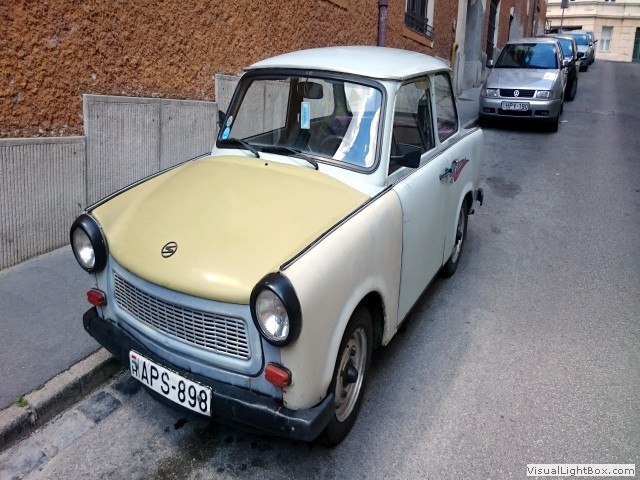 After the war and despite Stalin’s promises there would be democratic elections, each
communist country was in turn transformed into a satellite of Russia. In 1953 the Hungarians
revolted against their communist regime. The Soviet Union and several other members of the
Warsaw Pact invaded Hungary and brutally put down the revolt. A visit to the ‘Terror
háza’ Museum (house of terror) will humble anyone, it served in succession as the secret police headquarters
of Hungary's fascist and communist governments. Personally speaking, and as
a tourist it’s hard to imagine living under such an oppressive regime. I can’t comment
on how better or worse the country is today as a democratic nation, all I can say
is; I thoroughly enjoyed myself in Hungary, I felt completely safe (except for the
herds of segways), it’s a beautiful country and the people are really nice.
After the war and despite Stalin’s promises there would be democratic elections, each
communist country was in turn transformed into a satellite of Russia. In 1953 the Hungarians
revolted against their communist regime. The Soviet Union and several other members of the
Warsaw Pact invaded Hungary and brutally put down the revolt. A visit to the ‘Terror
háza’ Museum (house of terror) will humble anyone, it served in succession as the secret police headquarters
of Hungary's fascist and communist governments. Personally speaking, and as
a tourist it’s hard to imagine living under such an oppressive regime. I can’t comment
on how better or worse the country is today as a democratic nation, all I can say
is; I thoroughly enjoyed myself in Hungary, I felt completely safe (except for the
herds of segways), it’s a beautiful country and the people are really nice.
And the whole trip
 I had great weather and although the route was mostly flat (the old towpaths along
the river made excellent cycle tracks), it wasn’t without some inclines if you go
through the local villages, the mileage was supposed to be around 40 miles a day,
but ended up being on average 48 miles a day. Every province was different, starting
with steep wooded valleys with cascading waterfalls dribbling water over the path
(where the culverts couldn’t cope). If you like castles, then this is the land for you. There
were fairy castles galore- it seemed on top of every hill was a castle.
I had great weather and although the route was mostly flat (the old towpaths along
the river made excellent cycle tracks), it wasn’t without some inclines if you go
through the local villages, the mileage was supposed to be around 40 miles a day,
but ended up being on average 48 miles a day. Every province was different, starting
with steep wooded valleys with cascading waterfalls dribbling water over the path
(where the culverts couldn’t cope). If you like castles, then this is the land for you. There
were fairy castles galore- it seemed on top of every hill was a castle.
Tears were shed at the concentration camp at Mauthausen, and then onto the gentle rolling hills of the Wachau region, almost completely striped with vineyards, and dotted with medieval character villages. The landscape was attractive and diverse, with a wealth of cultural monuments (you can never have enough time to explore these, but it’s a double edge sword. If the mileage was cut in half, it would enable more/ longer visits to the attractions, but then the costs would double). Each place I stayed at was excellent (some better than others), the 5☆ Budapest hotel was 40% cheaper than the 3☆ Vienna hotel (but it was exceptionally clean). Despite predictions; the route wasn’t overcrowded (except in the Wachau region), the food was superb and the beer was 'ausgezeichnet'. It was a incredible and unique experience.
-
Gallery
 Why not have a look at the gallery relating to this ride. Click the image or the title.
Why not have a look at the gallery relating to this ride. Click the image or the title. -
The Planning
There are several companies along the Danube who will hire you a bike for the whole journey, I decided to use my own bike, and now the only issue was how to get it to the start point. Taking your bike on the Eurostar™ train is simple enough, you just book a bike space, but taking it in a bike bag is different, because of their weight and size limits, the bike had to go as independent luggage (not on the train). Eurostars' own ‘EuroDespatch First Luggage’ quoted £100 door to door delivery to Germany, but look around for quotes.
I could've flown to Passau, but the train is more adventurous. I booked the trip using the Deutsche Bahn site (the German National railway website) and booked exactly the same route, same times, £20 cheaper than the British Eurostar company offered. There are loads of companies who would organise your trip along the Danube, including booking all your accommodation, the advantage of this is you can start and finish at the same place and your choice company will transport you and your bags back to the start point, but never being the one for the easy option, I booked all the hotels myself. -
Hohenzollernbrücke Bridge
 Thousands of tourists and residents in Cologne affix ‘love padlocks’ on the Hohenzollernbrücke railway Bridge as a
symbol of their affections. A bit soppy really?
Thousands of tourists and residents in Cologne affix ‘love padlocks’ on the Hohenzollernbrücke railway Bridge as a
symbol of their affections. A bit soppy really? -
Cologne cathedral
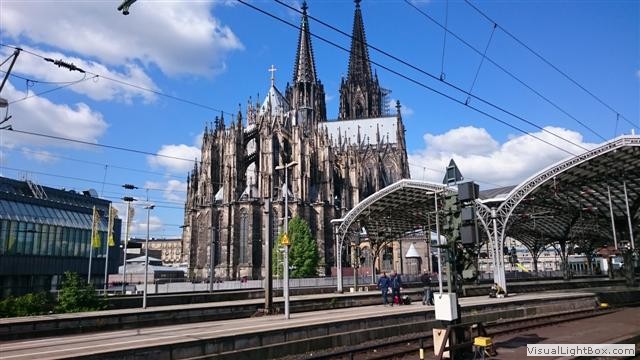 Cologne cathedral is the tallest Gothic architectural building found anywhere in the
world. Started during the thirteenth century, the Cathedral took more than six centuries to be
completed. I’m glad this minster wasn’t another casualty of WW2.
Cologne cathedral is the tallest Gothic architectural building found anywhere in the
world. Started during the thirteenth century, the Cathedral took more than six centuries to be
completed. I’m glad this minster wasn’t another casualty of WW2. -
The 'Bad girl' of Passau
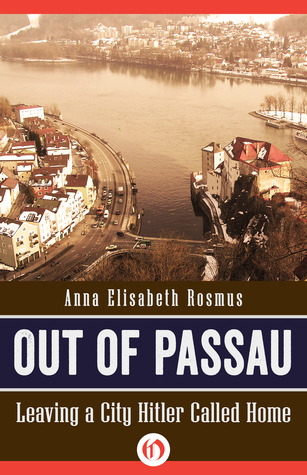 Anna Rosmus entered a national essay competition in 1981, innocently entitled 'My home town,
1933-39', she left no stone unturned in her quest to reveal the extent to which the town
connived in Nazi atrocities. Following a book and a film about her discoveries, she still
receives two death threats a week.
Anna Rosmus entered a national essay competition in 1981, innocently entitled 'My home town,
1933-39', she left no stone unturned in her quest to reveal the extent to which the town
connived in Nazi atrocities. Following a book and a film about her discoveries, she still
receives two death threats a week. -
Schanzl bridge Passau
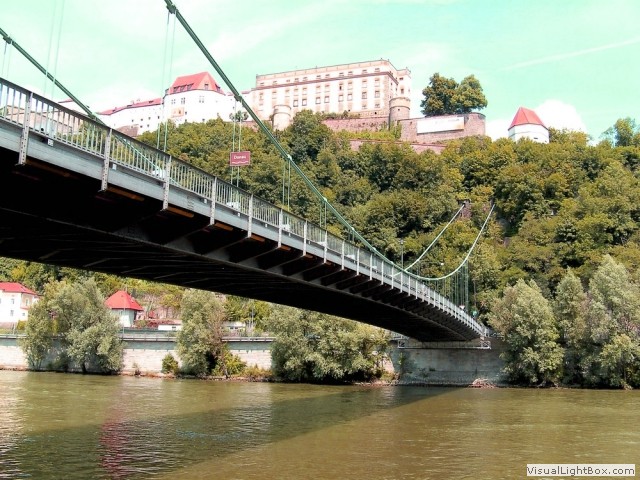 There’s nothing architecturally fantastic about the 'Schanzl' bridge in Passau, the marvel lies with
the point at which the bridge cross’s the Danube. During the Napoleonic wars the bridge was destroyed,
by the retreating forces, in WW1 the current bridge was destroyed, during the Second World War the bridge
destroyed by bombs and rebuilt after the war, which was then demolished in the 1970’s. Is this bridge
jinxed or what?
There’s nothing architecturally fantastic about the 'Schanzl' bridge in Passau, the marvel lies with
the point at which the bridge cross’s the Danube. During the Napoleonic wars the bridge was destroyed,
by the retreating forces, in WW1 the current bridge was destroyed, during the Second World War the bridge
destroyed by bombs and rebuilt after the war, which was then demolished in the 1970’s. Is this bridge
jinxed or what? -
Smiley unhappy people
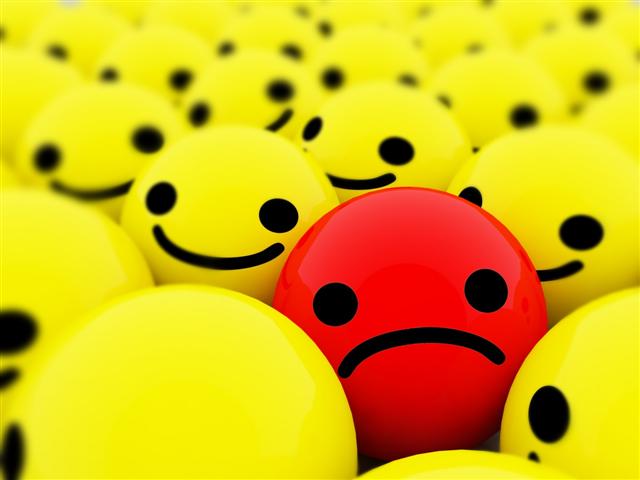 Despite living in a country with a high quality of life, a relatively thriving economy, a stable
political system, and beautiful countryside only one in five Austrians say they are truly happy,
according to a two year study from Vienna’s Modul University.
Despite living in a country with a high quality of life, a relatively thriving economy, a stable
political system, and beautiful countryside only one in five Austrians say they are truly happy,
according to a two year study from Vienna’s Modul University. -
Neuhaus Castle
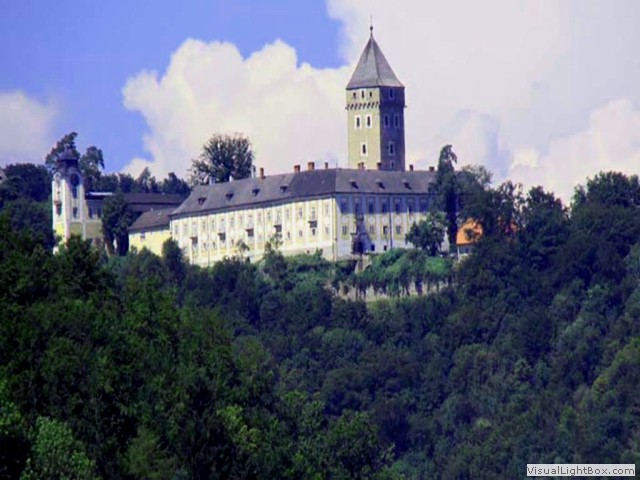 To the left of my hotel high on a cliff top stands Neuhaus Castle, built in the 12th century, it
was used as a hunting lodge by the bishops of Passau. Now privately owned you can’t enter, but
even a walk around the boundaries of the castle, travels you back into the time of knights
and chatelaines.
To the left of my hotel high on a cliff top stands Neuhaus Castle, built in the 12th century, it
was used as a hunting lodge by the bishops of Passau. Now privately owned you can’t enter, but
even a walk around the boundaries of the castle, travels you back into the time of knights
and chatelaines. -
The Aschach River
The River Danube is no stranger to a turbulent time, but despite the river being the cleanest for centuries some fish are on the decline. A combination of dams, pollution, and illegal fishing has driven some fish to the brink of extinction. Part of the regeneration of some fish is helped by the artificial lakes and breading areas in the Aschach river.
-
Ottesnehim castle
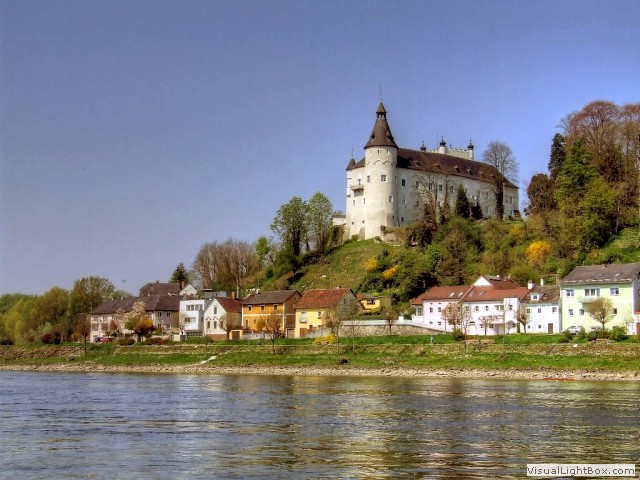 In 1148 the Ottesnehim castle was occupied by the Brothers Ulrich and Cholo of Wilhering, they had
another castle at the opposite shore of the Danube. Rumours have it that a tunnel under the Danube
links the two Castles. It was owned by the sovereign to 1527, then Emperor Ferdinand gave the castle
and the market town of Ottesnehim as a present to his chancellor. Today it’s privately owned, so
I couldn’t visit it.
In 1148 the Ottesnehim castle was occupied by the Brothers Ulrich and Cholo of Wilhering, they had
another castle at the opposite shore of the Danube. Rumours have it that a tunnel under the Danube
links the two Castles. It was owned by the sovereign to 1527, then Emperor Ferdinand gave the castle
and the market town of Ottesnehim as a present to his chancellor. Today it’s privately owned, so
I couldn’t visit it. -
KZ-Gedenkstätte Mauthausen
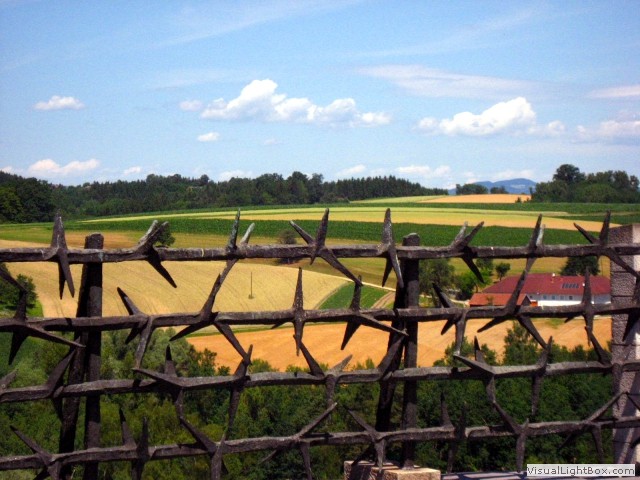 The Nazis' most brutal concentration camp was located in the picturesque Austrian countryside near
Mauthausen, the conditions the prisoners had to endure were far
harsher than those that existed in other camps. The prisoners were worked in Weinergraben
(or 'Vienna Ditch') a granite quarry, where there was a 300 foot crevice which was
separated from the main camp by a set of steps and jagged cliffs. The steps were known
as the 'death steps', because prisoners were often forced to run up the them carrying heavy
rocks, while being shot at or beaten. The jagged cliffs were also known as the 'parachute
jump', and its victims were called 'paratroopers' since SS guards regularly threw prisoners off the
cliffs to their death into the quarry below. The inmates had a life expectancy of three months.
The Nazis' most brutal concentration camp was located in the picturesque Austrian countryside near
Mauthausen, the conditions the prisoners had to endure were far
harsher than those that existed in other camps. The prisoners were worked in Weinergraben
(or 'Vienna Ditch') a granite quarry, where there was a 300 foot crevice which was
separated from the main camp by a set of steps and jagged cliffs. The steps were known
as the 'death steps', because prisoners were often forced to run up the them carrying heavy
rocks, while being shot at or beaten. The jagged cliffs were also known as the 'parachute
jump', and its victims were called 'paratroopers' since SS guards regularly threw prisoners off the
cliffs to their death into the quarry below. The inmates had a life expectancy of three months. -
Schleuse Wallsee-Mitterkirchen
 The mighty Danube was straightened and relocated here. Slightly to the south, the Danube
went around a tight bend which was treacherous to shipping, it had to be corrected, promoting
the largest excavation of earth in Austria ever, which at the time was the largest construction
site in Europe employing 3000 workers.
The mighty Danube was straightened and relocated here. Slightly to the south, the Danube
went around a tight bend which was treacherous to shipping, it had to be corrected, promoting
the largest excavation of earth in Austria ever, which at the time was the largest construction
site in Europe employing 3000 workers. -
Schloss Persenbeug
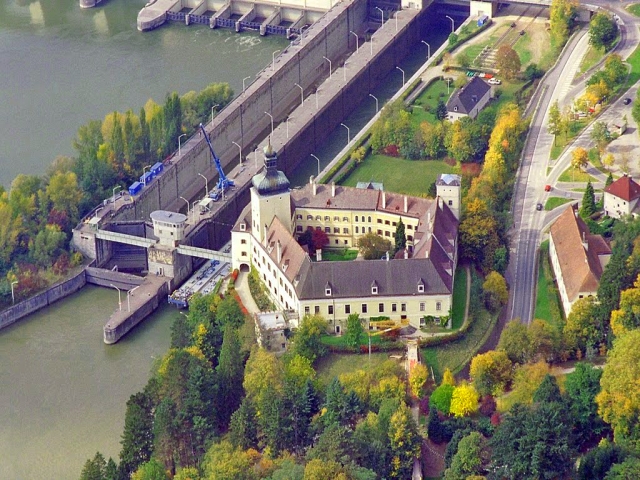 The first historical mention of the castle Persenbeug dates back to the year 970 AD. Persenbeug
castle forms architecturally around a pentagon shape, with a spacious inner courtyard and a
simple central fountain. During one of the castles engagements a floor collapsed killing
many of the party. It has changed hands hundreds of times and is now a private residence.
The first historical mention of the castle Persenbeug dates back to the year 970 AD. Persenbeug
castle forms architecturally around a pentagon shape, with a spacious inner courtyard and a
simple central fountain. During one of the castles engagements a floor collapsed killing
many of the party. It has changed hands hundreds of times and is now a private residence. -
Kaffee & kuchen
 I’ll admit it: I enjoy the sweeter things in life. If given the choice between savory
or sweet, I’m almost always going to reach for the sweets. Fortunately, this predilection
brought me to a most wonderful tradition, known in Bavaria as kaffee und kuchen (coffee
and cake). What makes this tradition so beautiful and so accessible is Austria’s endless
line of bakeries and cafes. If you are averse to heavy cream, butter, fat and loads of
sugar, then sadly this isn’t a tradition for you.
I’ll admit it: I enjoy the sweeter things in life. If given the choice between savory
or sweet, I’m almost always going to reach for the sweets. Fortunately, this predilection
brought me to a most wonderful tradition, known in Bavaria as kaffee und kuchen (coffee
and cake). What makes this tradition so beautiful and so accessible is Austria’s endless
line of bakeries and cafes. If you are averse to heavy cream, butter, fat and loads of
sugar, then sadly this isn’t a tradition for you. -
Schloss Schönbühel
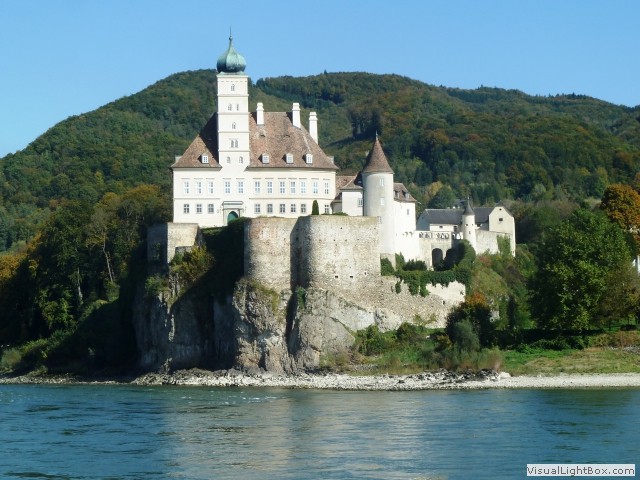 The castle is built on rock 130 ft above the level of the river Danube. The castle was
begun in the early 12th century by Marchwardus de Schoenbuchele as a defensive fortress. The
castle was briefly owned by Conrad von Eisenbeutel, and then by the Abbey of Melk. In 1396 it
was sold to the brothers Caspar and Gundaker von Starhemberg. It remained in the Starhemberg
family for more than 400 years, but then fell into disrepair, today it’s thriving and looks
fantastic from my side.
The castle is built on rock 130 ft above the level of the river Danube. The castle was
begun in the early 12th century by Marchwardus de Schoenbuchele as a defensive fortress. The
castle was briefly owned by Conrad von Eisenbeutel, and then by the Abbey of Melk. In 1396 it
was sold to the brothers Caspar and Gundaker von Starhemberg. It remained in the Starhemberg
family for more than 400 years, but then fell into disrepair, today it’s thriving and looks
fantastic from my side. -
Spitz an der Donau
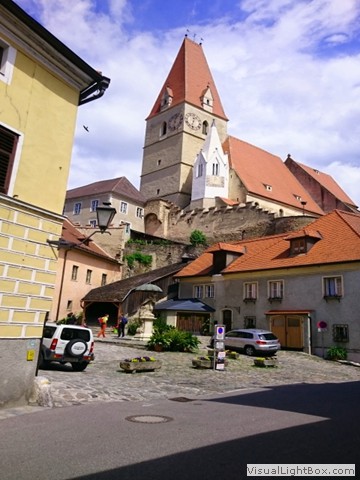 Built around the so-called ‘Thousand-bucket-hill’, grapes grow right in the middle of Spitz
and spill over to the terraced vineyards surrounding the town. This is truly an ancient wine
grower´s village with Renaissance and Baroque houses, there’s a beautiful square in
front of the late gothic church. Touristy but nice.
Built around the so-called ‘Thousand-bucket-hill’, grapes grow right in the middle of Spitz
and spill over to the terraced vineyards surrounding the town. This is truly an ancient wine
grower´s village with Renaissance and Baroque houses, there’s a beautiful square in
front of the late gothic church. Touristy but nice. -
Love cycling, hate the pain
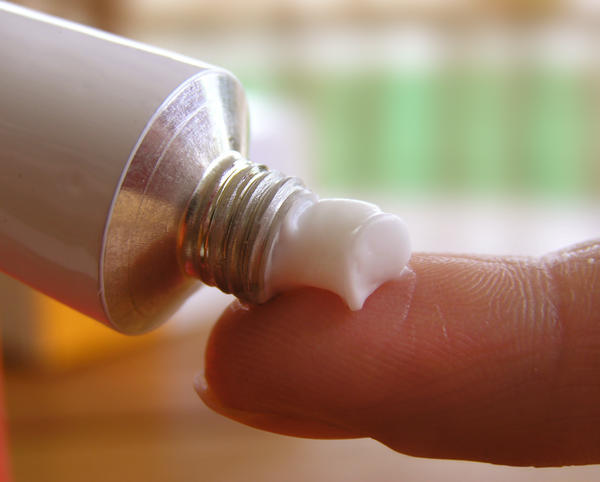 Haemorrhoids are caused by inflamed veins around the anus; they can be unpleasant
and painful. Cycling can exacerbate existing haemorrhoids by restricting
blood flow to the rectum. If haemorrhoids are producing pain during your rides, use creams
on the pad containing zinc oxide, calendula, aloe, jojoba oil, and lidocaine. Or use freely
to numb the area if the pain is intolerable.
Haemorrhoids are caused by inflamed veins around the anus; they can be unpleasant
and painful. Cycling can exacerbate existing haemorrhoids by restricting
blood flow to the rectum. If haemorrhoids are producing pain during your rides, use creams
on the pad containing zinc oxide, calendula, aloe, jojoba oil, and lidocaine. Or use freely
to numb the area if the pain is intolerable. -
Dürnstein castle
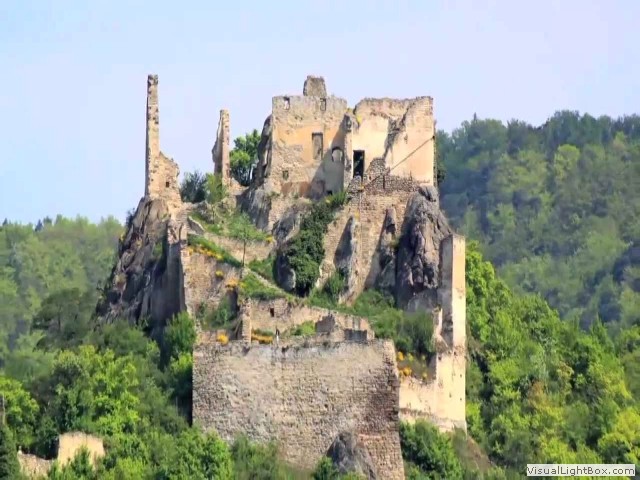 The town of Dürnstein gained its name from the medieval castle which overlooks it ‘Burgruine
Dürnstein’. The castle gained notoriety in 1192 when, King Richard I of England was
held captive there by Leopold V (Duke of Austria) after a dispute during the Third Crusade.
Richard the Lionheart had offended Leopold the Virtuous by casting down his standard from
the walls at the Battle of Acre.
The town of Dürnstein gained its name from the medieval castle which overlooks it ‘Burgruine
Dürnstein’. The castle gained notoriety in 1192 when, King Richard I of England was
held captive there by Leopold V (Duke of Austria) after a dispute during the Third Crusade.
Richard the Lionheart had offended Leopold the Virtuous by casting down his standard from
the walls at the Battle of Acre. -
Tulln
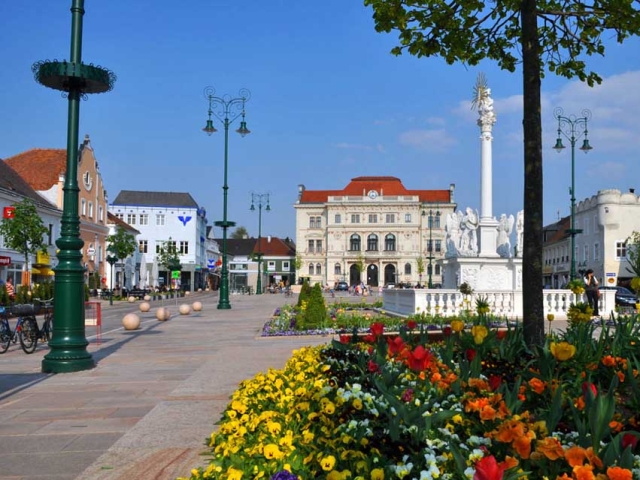 Tulln is quite a boring little Bavarian town, though one of the oldest hamlets in Austria
and considering it’s centuries old originating back to Roman origin and may have been
involved in the Hussite wars, the Turkish sieges, it is remarkable
how absolutely un-happening this scenic place by the Danube is.
Tulln is quite a boring little Bavarian town, though one of the oldest hamlets in Austria
and considering it’s centuries old originating back to Roman origin and may have been
involved in the Hussite wars, the Turkish sieges, it is remarkable
how absolutely un-happening this scenic place by the Danube is. -
The Nibelungen Brunnen monument
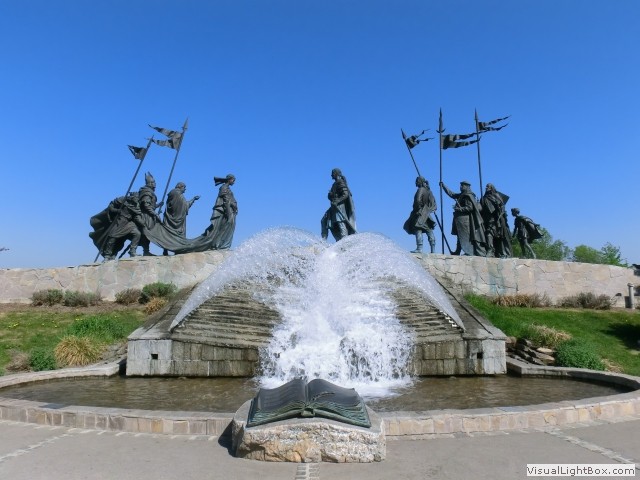 The Nibelung Fountain is truly a sight to behold. With the integrated and aesthetic light-water-stone
composition of the statues and fountains of water rising out of an open book. The fountains alternately
become stronger on each side until their streams of water finally touch and mix – this feature also
corresponds to the symbolism of two worlds, East and West, approaching each other in Tulln.
The Nibelung Fountain is truly a sight to behold. With the integrated and aesthetic light-water-stone
composition of the statues and fountains of water rising out of an open book. The fountains alternately
become stronger on each side until their streams of water finally touch and mix – this feature also
corresponds to the symbolism of two worlds, East and West, approaching each other in Tulln. -
Graffiti artists of Vienna
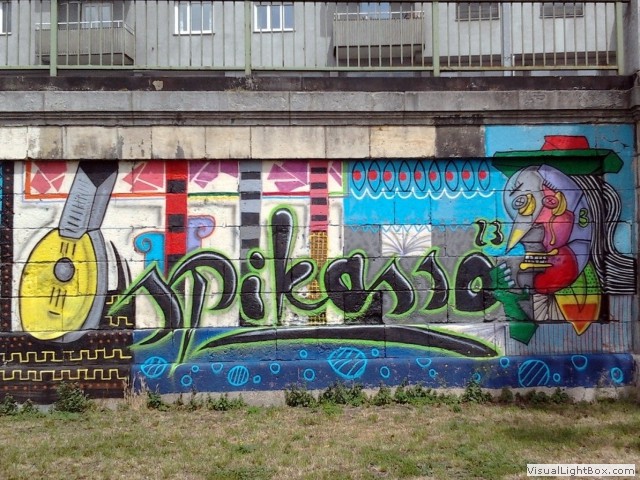 Art is defiantly subjective and I would only consider paying a reasonable price for bricks- in order to
build a wall (In 1976 in the Tate gallery paid £11500 (in todays money) for a ‘sculpture’ of 120 firebricks arranged
in a rectangular formation), but I was in awe of the walls of art that introduced me to Vienna. Apparently in
Vienna, it’s not such a big deal to see amateur graffiti artists spraying their mind and
soul onto the walls, much to the annoyance of the traditional classical Viennese artisans.
Art is defiantly subjective and I would only consider paying a reasonable price for bricks- in order to
build a wall (In 1976 in the Tate gallery paid £11500 (in todays money) for a ‘sculpture’ of 120 firebricks arranged
in a rectangular formation), but I was in awe of the walls of art that introduced me to Vienna. Apparently in
Vienna, it’s not such a big deal to see amateur graffiti artists spraying their mind and
soul onto the walls, much to the annoyance of the traditional classical Viennese artisans. The highlights of Vienna
-
The Hofburg- Imperial Palace
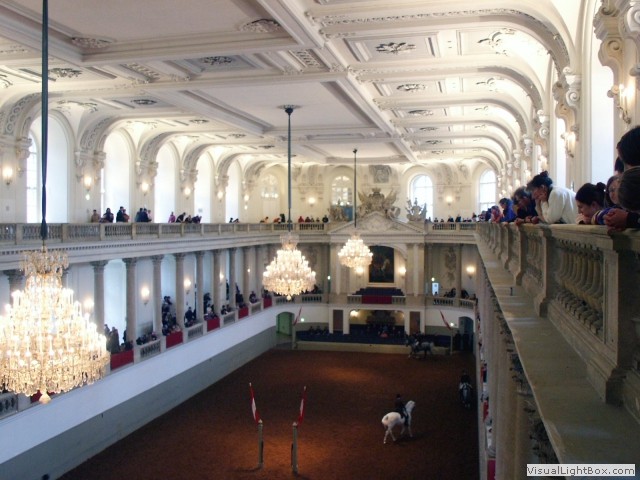 The Hofburg in Vienna is the official seat of the Austrian President. There’s cafés,
restaurants, and museums on the same site, but it's famed for its Spanish riding school, and don't get
me wrong; they are nice horses, but be prepared for the biggest rip off in Vienna. The
School in Vienna is the only institution in the world where the classic
equestrian skills (haute école) have been preserved and in my opinion; I could easily
train an octopus to move in the same way as those Lipizzan Stallions. So, don't waste your money.
The Hofburg in Vienna is the official seat of the Austrian President. There’s cafés,
restaurants, and museums on the same site, but it's famed for its Spanish riding school, and don't get
me wrong; they are nice horses, but be prepared for the biggest rip off in Vienna. The
School in Vienna is the only institution in the world where the classic
equestrian skills (haute école) have been preserved and in my opinion; I could easily
train an octopus to move in the same way as those Lipizzan Stallions. So, don't waste your money.
-
The Rathaus
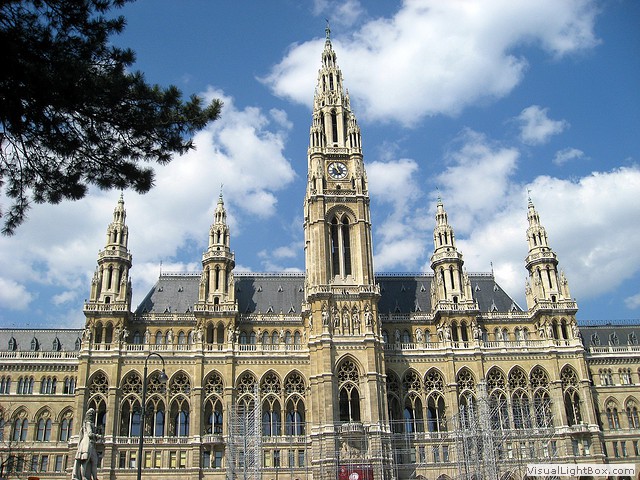 One of the most striking buildings on the Ringstrasse is Vienna’s City Hall. This massive
late 19th-century neo-Gothic building is the seat of the City Council of Vienna.
One of the most striking buildings on the Ringstrasse is Vienna’s City Hall. This massive
late 19th-century neo-Gothic building is the seat of the City Council of Vienna. -
The Schönbrunn Palace (shown on the left)
A beautiful place, and certainly worth a visit, the grounds are fantastic and have great views of the city. I pushed the bike around the grounds (which was a bit of a pain really because of the terrain), and had a coffee in a hexagon cafe, it was great.
-
The Prater
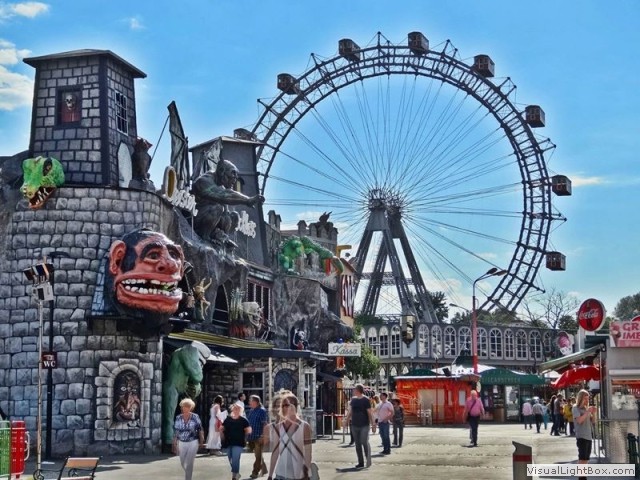 Childhood nostalgia comes alive at the Prater (on a smaller scale this funfair reminds me of Belle Vue
amusement park in Manchester, which closed in the eighties), Vienna's famous amusement
park boasts of a 212-ft tall ferris wheel, constructed in 1897, it was the world's tallest
until 1985. Apart from the Ferris wheel, there are old-fashioned merry-go-rounds, roller coasters,
punch and judy shows, ghost trains and everything an old fair should have (including donuts). It truly emulates an
original Victorian fair using popular Victorian period colours.
Childhood nostalgia comes alive at the Prater (on a smaller scale this funfair reminds me of Belle Vue
amusement park in Manchester, which closed in the eighties), Vienna's famous amusement
park boasts of a 212-ft tall ferris wheel, constructed in 1897, it was the world's tallest
until 1985. Apart from the Ferris wheel, there are old-fashioned merry-go-rounds, roller coasters,
punch and judy shows, ghost trains and everything an old fair should have (including donuts). It truly emulates an
original Victorian fair using popular Victorian period colours. The highlights of Budapest
-
Széchenyi Baths
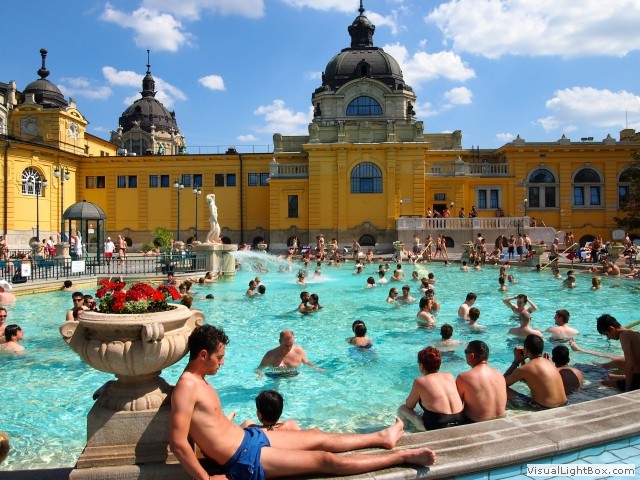 A Budapest institution, the Széchenyi baths are worth visiting even if the thought of spending
an hour or two wallowing alongside swarms of people doesn’t appeal.
The 100 year old building housing the baths is simply stunning, while the sheer size of the
complex makes this spa experience different from any other.
A Budapest institution, the Széchenyi baths are worth visiting even if the thought of spending
an hour or two wallowing alongside swarms of people doesn’t appeal.
The 100 year old building housing the baths is simply stunning, while the sheer size of the
complex makes this spa experience different from any other. -
Buda castle
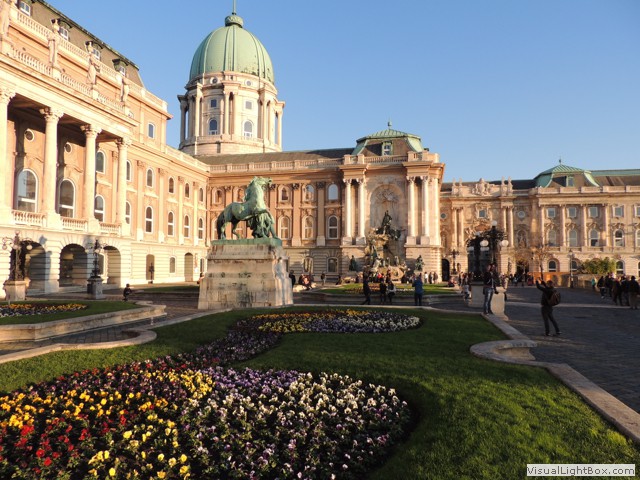 Buda Castle is the historical palace complex and residence of previous Hungarian kings. The
first stage was completed in 1265, but the massive Baroque palace occupying the site today
was finaly finished in 1769.
Buda Castle is the historical palace complex and residence of previous Hungarian kings. The
first stage was completed in 1265, but the massive Baroque palace occupying the site today
was finaly finished in 1769. -
Hungarian parliament
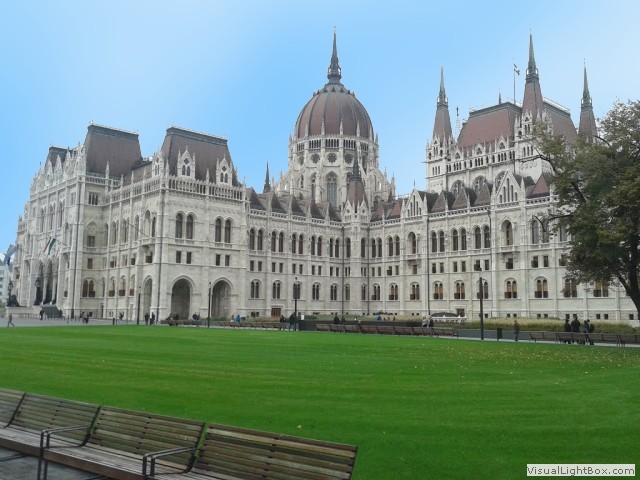 This impressive neo-Gothic structure was built at the turn of the 19th/20th century and remains
Hungary’s largest building, perhaps best seen from the Danube.
This impressive neo-Gothic structure was built at the turn of the 19th/20th century and remains
Hungary’s largest building, perhaps best seen from the Danube. -
Citadella (shown on the left)
Built in the mid-nineteenth century as a fortress, this has been the scene of many military coups, when the Austrians finally left the fort in 1899 the surrounding walls were destroyed as a symbol that Hungry wouldn’t be held to ransom again, but in the Hungarian Revolution of 1956, Soviet troops occupied the Citadella and fired down into the city during the assault that overthrew the Nagy-led Hungarian government.
-
Matthias church
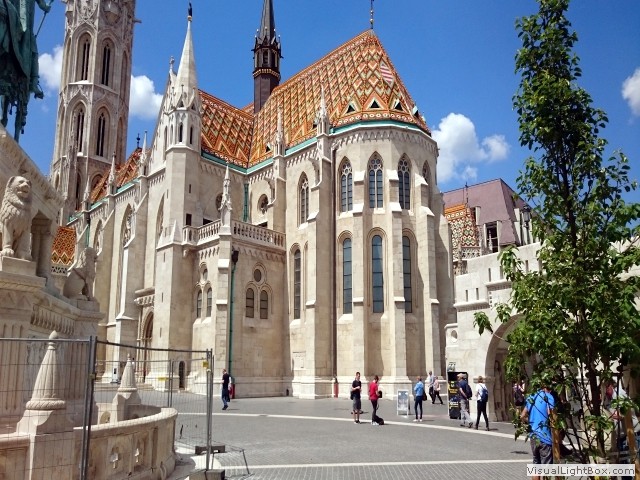 This thousand year old church has been destroyed by the Mongols, then rebuilt and destroyed
again during WW2, it has been changed into a mosque and back to a catholic church and held
the last two Hungarian Habsburg kings’ coronations. Today it’s extremely touristy with ice
cream parlours in every nook and cranny and even a massive hotel built on the back of it,
but the views of ‘Pest’ are tremendous.
This thousand year old church has been destroyed by the Mongols, then rebuilt and destroyed
again during WW2, it has been changed into a mosque and back to a catholic church and held
the last two Hungarian Habsburg kings’ coronations. Today it’s extremely touristy with ice
cream parlours in every nook and cranny and even a massive hotel built on the back of it,
but the views of ‘Pest’ are tremendous. -
Terror háza
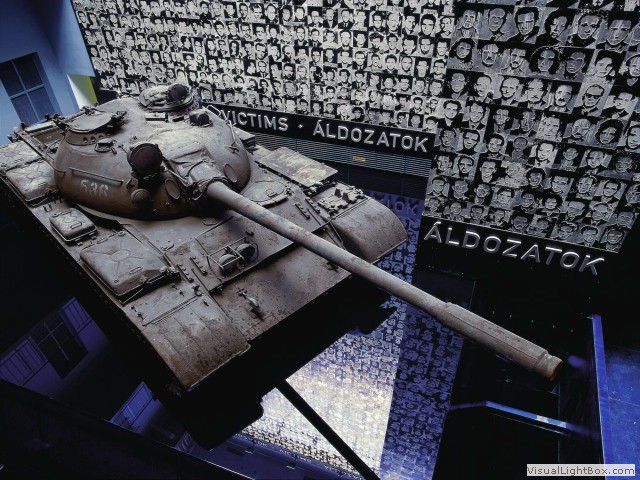 On a normal street, sits an ominous building, which in the past; housed the secret police of the
Arrow Cross (a Nazi wannabe group in WW2) and the communist ÁVH (similar to the USSR KGB
secret police) during the decades of Soviet occupation. Inside there's some
unsettling music, giving an air of misery to the building which really sets the atmosphere. Top
tip- use the audio guide, as even though there is a lot of information in English, all the
descriptions of the objects are in Hungarian.
On a normal street, sits an ominous building, which in the past; housed the secret police of the
Arrow Cross (a Nazi wannabe group in WW2) and the communist ÁVH (similar to the USSR KGB
secret police) during the decades of Soviet occupation. Inside there's some
unsettling music, giving an air of misery to the building which really sets the atmosphere. Top
tip- use the audio guide, as even though there is a lot of information in English, all the
descriptions of the objects are in Hungarian. -
A fitting departure from Budapest
On the morning of my departure from Budapest I had about 2,050 Forint left (about £6 in UK sterling), I couldn’t change it back so I spent it on food in a local supermarket. The money went a long way and bought too much food for me alone. I sat next to a man with long dishevelled hair, wearing bedraggled clothing, clearly down on his luck and asked if he would share breakfast with me. He didn’t speak any English, and I didn’t speak Hungarian. We sat there munching, nodding, and smiling at each other using international body language. He waved goodbye as I stood up, it was a fitting end to a great cycling adventure.

 Thousands of tourists and residents in Cologne affix ‘love padlocks’ on the Hohenzollernbrücke railway Bridge as a
symbol of their affections. A bit soppy really?
Thousands of tourists and residents in Cologne affix ‘love padlocks’ on the Hohenzollernbrücke railway Bridge as a
symbol of their affections. A bit soppy really?  Cologne cathedral is the tallest Gothic architectural building found anywhere in the
world. Started during the thirteenth century, the Cathedral took more than six centuries to be
completed. I’m glad this minster wasn’t another casualty of WW2.
Cologne cathedral is the tallest Gothic architectural building found anywhere in the
world. Started during the thirteenth century, the Cathedral took more than six centuries to be
completed. I’m glad this minster wasn’t another casualty of WW2. Anna Rosmus entered a national essay competition in 1981, innocently entitled 'My home town,
1933-39', she left no stone unturned in her quest to reveal the extent to which the town
connived in Nazi atrocities. Following a book and a film about her discoveries, she still
receives two death threats a week.
Anna Rosmus entered a national essay competition in 1981, innocently entitled 'My home town,
1933-39', she left no stone unturned in her quest to reveal the extent to which the town
connived in Nazi atrocities. Following a book and a film about her discoveries, she still
receives two death threats a week. There’s nothing architecturally fantastic about the 'Schanzl' bridge in Passau, the marvel lies with
the point at which the bridge cross’s the Danube. During the Napoleonic wars the bridge was destroyed,
by the retreating forces, in WW1 the current bridge was destroyed, during the Second World War the bridge
destroyed by bombs and rebuilt after the war, which was then demolished in the 1970’s. Is this bridge
jinxed or what?
There’s nothing architecturally fantastic about the 'Schanzl' bridge in Passau, the marvel lies with
the point at which the bridge cross’s the Danube. During the Napoleonic wars the bridge was destroyed,
by the retreating forces, in WW1 the current bridge was destroyed, during the Second World War the bridge
destroyed by bombs and rebuilt after the war, which was then demolished in the 1970’s. Is this bridge
jinxed or what? Despite living in a country with a high quality of life, a relatively thriving economy, a stable
political system, and beautiful countryside only one in five Austrians say they are truly happy,
according to a two year study from Vienna’s Modul University.
Despite living in a country with a high quality of life, a relatively thriving economy, a stable
political system, and beautiful countryside only one in five Austrians say they are truly happy,
according to a two year study from Vienna’s Modul University. To the left of my hotel high on a cliff top stands Neuhaus Castle, built in the 12th century, it
was used as a hunting lodge by the bishops of Passau. Now privately owned you can’t enter, but
even a walk around the boundaries of the castle, travels you back into the time of knights
and chatelaines.
To the left of my hotel high on a cliff top stands Neuhaus Castle, built in the 12th century, it
was used as a hunting lodge by the bishops of Passau. Now privately owned you can’t enter, but
even a walk around the boundaries of the castle, travels you back into the time of knights
and chatelaines. In 1148 the Ottesnehim castle was occupied by the Brothers Ulrich and Cholo of Wilhering, they had
another castle at the opposite shore of the Danube. Rumours have it that a tunnel under the Danube
links the two Castles. It was owned by the sovereign to 1527, then Emperor Ferdinand gave the castle
and the market town of Ottesnehim as a present to his chancellor. Today it’s privately owned, so
I couldn’t visit it.
In 1148 the Ottesnehim castle was occupied by the Brothers Ulrich and Cholo of Wilhering, they had
another castle at the opposite shore of the Danube. Rumours have it that a tunnel under the Danube
links the two Castles. It was owned by the sovereign to 1527, then Emperor Ferdinand gave the castle
and the market town of Ottesnehim as a present to his chancellor. Today it’s privately owned, so
I couldn’t visit it.  The Nazis' most brutal concentration camp was located in the picturesque Austrian countryside near
Mauthausen, the conditions the prisoners had to endure were far
harsher than those that existed in other camps. The prisoners were worked in Weinergraben
(or 'Vienna Ditch') a granite quarry, where there was a 300 foot crevice which was
separated from the main camp by a set of steps and jagged cliffs. The steps were known
as the 'death steps', because prisoners were often forced to run up the them carrying heavy
rocks, while being shot at or beaten. The jagged cliffs were also known as the 'parachute
jump', and its victims were called 'paratroopers' since SS guards regularly threw prisoners off the
cliffs to their death into the quarry below. The inmates had a life expectancy of three months.
The Nazis' most brutal concentration camp was located in the picturesque Austrian countryside near
Mauthausen, the conditions the prisoners had to endure were far
harsher than those that existed in other camps. The prisoners were worked in Weinergraben
(or 'Vienna Ditch') a granite quarry, where there was a 300 foot crevice which was
separated from the main camp by a set of steps and jagged cliffs. The steps were known
as the 'death steps', because prisoners were often forced to run up the them carrying heavy
rocks, while being shot at or beaten. The jagged cliffs were also known as the 'parachute
jump', and its victims were called 'paratroopers' since SS guards regularly threw prisoners off the
cliffs to their death into the quarry below. The inmates had a life expectancy of three months. The mighty Danube was straightened and relocated here. Slightly to the south, the Danube
went around a tight bend which was treacherous to shipping, it had to be corrected, promoting
the largest excavation of earth in Austria ever, which at the time was the largest construction
site in Europe employing 3000 workers.
The mighty Danube was straightened and relocated here. Slightly to the south, the Danube
went around a tight bend which was treacherous to shipping, it had to be corrected, promoting
the largest excavation of earth in Austria ever, which at the time was the largest construction
site in Europe employing 3000 workers. The first historical mention of the castle Persenbeug dates back to the year 970 AD. Persenbeug
castle forms architecturally around a pentagon shape, with a spacious inner courtyard and a
simple central fountain. During one of the castles engagements a floor collapsed killing
many of the party. It has changed hands hundreds of times and is now a private residence.
The first historical mention of the castle Persenbeug dates back to the year 970 AD. Persenbeug
castle forms architecturally around a pentagon shape, with a spacious inner courtyard and a
simple central fountain. During one of the castles engagements a floor collapsed killing
many of the party. It has changed hands hundreds of times and is now a private residence.  I’ll admit it: I enjoy the sweeter things in life. If given the choice between savory
or sweet, I’m almost always going to reach for the sweets. Fortunately, this predilection
brought me to a most wonderful tradition, known in Bavaria as kaffee und kuchen (coffee
and cake). What makes this tradition so beautiful and so accessible is Austria’s endless
line of bakeries and cafes. If you are averse to heavy cream, butter, fat and loads of
sugar, then sadly this isn’t a tradition for you.
I’ll admit it: I enjoy the sweeter things in life. If given the choice between savory
or sweet, I’m almost always going to reach for the sweets. Fortunately, this predilection
brought me to a most wonderful tradition, known in Bavaria as kaffee und kuchen (coffee
and cake). What makes this tradition so beautiful and so accessible is Austria’s endless
line of bakeries and cafes. If you are averse to heavy cream, butter, fat and loads of
sugar, then sadly this isn’t a tradition for you. The castle is built on rock 130 ft above the level of the river Danube. The castle was
begun in the early 12th century by Marchwardus de Schoenbuchele as a defensive fortress. The
castle was briefly owned by Conrad von Eisenbeutel, and then by the Abbey of Melk. In 1396 it
was sold to the brothers Caspar and Gundaker von Starhemberg. It remained in the Starhemberg
family for more than 400 years, but then fell into disrepair, today it’s thriving and looks
fantastic from my side.
The castle is built on rock 130 ft above the level of the river Danube. The castle was
begun in the early 12th century by Marchwardus de Schoenbuchele as a defensive fortress. The
castle was briefly owned by Conrad von Eisenbeutel, and then by the Abbey of Melk. In 1396 it
was sold to the brothers Caspar and Gundaker von Starhemberg. It remained in the Starhemberg
family for more than 400 years, but then fell into disrepair, today it’s thriving and looks
fantastic from my side. Built around the so-called ‘Thousand-bucket-hill’, grapes grow right in the middle of Spitz
and spill over to the terraced vineyards surrounding the town. This is truly an ancient wine
grower´s village with Renaissance and Baroque houses, there’s a beautiful square in
front of the late gothic church. Touristy but nice.
Built around the so-called ‘Thousand-bucket-hill’, grapes grow right in the middle of Spitz
and spill over to the terraced vineyards surrounding the town. This is truly an ancient wine
grower´s village with Renaissance and Baroque houses, there’s a beautiful square in
front of the late gothic church. Touristy but nice. Haemorrhoids are caused by inflamed veins around the anus; they can be unpleasant
and painful. Cycling can exacerbate existing haemorrhoids by restricting
blood flow to the rectum. If haemorrhoids are producing pain during your rides, use creams
on the pad containing zinc oxide, calendula, aloe, jojoba oil, and lidocaine. Or use freely
to numb the area if the pain is intolerable.
Haemorrhoids are caused by inflamed veins around the anus; they can be unpleasant
and painful. Cycling can exacerbate existing haemorrhoids by restricting
blood flow to the rectum. If haemorrhoids are producing pain during your rides, use creams
on the pad containing zinc oxide, calendula, aloe, jojoba oil, and lidocaine. Or use freely
to numb the area if the pain is intolerable. The town of Dürnstein gained its name from the medieval castle which overlooks it ‘Burgruine
Dürnstein’. The castle gained notoriety in 1192 when, King Richard I of England was
held captive there by Leopold V (Duke of Austria) after a dispute during the Third Crusade.
Richard the Lionheart had offended Leopold the Virtuous by casting down his standard from
the walls at the Battle of Acre.
The town of Dürnstein gained its name from the medieval castle which overlooks it ‘Burgruine
Dürnstein’. The castle gained notoriety in 1192 when, King Richard I of England was
held captive there by Leopold V (Duke of Austria) after a dispute during the Third Crusade.
Richard the Lionheart had offended Leopold the Virtuous by casting down his standard from
the walls at the Battle of Acre. Tulln is quite a boring little Bavarian town, though one of the oldest hamlets in Austria
and considering it’s centuries old originating back to Roman origin and may have been
involved in the Hussite wars, the Turkish sieges, it is remarkable
how absolutely un-happening this scenic place by the Danube is.
Tulln is quite a boring little Bavarian town, though one of the oldest hamlets in Austria
and considering it’s centuries old originating back to Roman origin and may have been
involved in the Hussite wars, the Turkish sieges, it is remarkable
how absolutely un-happening this scenic place by the Danube is. The Nibelung Fountain is truly a sight to behold. With the integrated and aesthetic light-water-stone
composition of the statues and fountains of water rising out of an open book. The fountains alternately
become stronger on each side until their streams of water finally touch and mix – this feature also
corresponds to the symbolism of two worlds, East and West, approaching each other in Tulln.
The Nibelung Fountain is truly a sight to behold. With the integrated and aesthetic light-water-stone
composition of the statues and fountains of water rising out of an open book. The fountains alternately
become stronger on each side until their streams of water finally touch and mix – this feature also
corresponds to the symbolism of two worlds, East and West, approaching each other in Tulln. Art is defiantly subjective and I would only consider paying a reasonable price for bricks- in order to
build a wall (In 1976 in the Tate gallery paid £11500 (in todays money) for a ‘sculpture’ of 120 firebricks arranged
in a rectangular formation), but I was in awe of the walls of art that introduced me to Vienna. Apparently in
Vienna, it’s not such a big deal to see amateur graffiti artists spraying their mind and
soul onto the walls, much to the annoyance of the traditional classical Viennese artisans.
Art is defiantly subjective and I would only consider paying a reasonable price for bricks- in order to
build a wall (In 1976 in the Tate gallery paid £11500 (in todays money) for a ‘sculpture’ of 120 firebricks arranged
in a rectangular formation), but I was in awe of the walls of art that introduced me to Vienna. Apparently in
Vienna, it’s not such a big deal to see amateur graffiti artists spraying their mind and
soul onto the walls, much to the annoyance of the traditional classical Viennese artisans. The Hofburg in Vienna is the official seat of the Austrian President. There’s cafés,
restaurants, and museums on the same site, but it's famed for its Spanish riding school, and don't get
me wrong; they are nice horses, but be prepared for the biggest rip off in Vienna. The
School in Vienna is the only institution in the world where the classic
equestrian skills (haute école) have been preserved and in my opinion; I could easily
train an octopus to move in the same way as those Lipizzan Stallions. So, don't waste your money.
The Hofburg in Vienna is the official seat of the Austrian President. There’s cafés,
restaurants, and museums on the same site, but it's famed for its Spanish riding school, and don't get
me wrong; they are nice horses, but be prepared for the biggest rip off in Vienna. The
School in Vienna is the only institution in the world where the classic
equestrian skills (haute école) have been preserved and in my opinion; I could easily
train an octopus to move in the same way as those Lipizzan Stallions. So, don't waste your money.
 One of the most striking buildings on the Ringstrasse is Vienna’s City Hall. This massive
late 19th-century neo-Gothic building is the seat of the City Council of Vienna.
One of the most striking buildings on the Ringstrasse is Vienna’s City Hall. This massive
late 19th-century neo-Gothic building is the seat of the City Council of Vienna. Childhood nostalgia comes alive at the Prater (on a smaller scale this funfair reminds me of Belle Vue
amusement park in Manchester, which closed in the eighties), Vienna's famous amusement
park boasts of a 212-ft tall ferris wheel, constructed in 1897, it was the world's tallest
until 1985. Apart from the Ferris wheel, there are old-fashioned merry-go-rounds, roller coasters,
punch and judy shows, ghost trains and everything an old fair should have (including donuts). It truly emulates an
original Victorian fair using popular Victorian period colours.
Childhood nostalgia comes alive at the Prater (on a smaller scale this funfair reminds me of Belle Vue
amusement park in Manchester, which closed in the eighties), Vienna's famous amusement
park boasts of a 212-ft tall ferris wheel, constructed in 1897, it was the world's tallest
until 1985. Apart from the Ferris wheel, there are old-fashioned merry-go-rounds, roller coasters,
punch and judy shows, ghost trains and everything an old fair should have (including donuts). It truly emulates an
original Victorian fair using popular Victorian period colours. A Budapest institution, the Széchenyi baths are worth visiting even if the thought of spending
an hour or two wallowing alongside swarms of people doesn’t appeal.
The 100 year old building housing the baths is simply stunning, while the sheer size of the
complex makes this spa experience different from any other.
A Budapest institution, the Széchenyi baths are worth visiting even if the thought of spending
an hour or two wallowing alongside swarms of people doesn’t appeal.
The 100 year old building housing the baths is simply stunning, while the sheer size of the
complex makes this spa experience different from any other. Buda Castle is the historical palace complex and residence of previous Hungarian kings. The
first stage was completed in 1265, but the massive Baroque palace occupying the site today
was finaly finished in 1769.
Buda Castle is the historical palace complex and residence of previous Hungarian kings. The
first stage was completed in 1265, but the massive Baroque palace occupying the site today
was finaly finished in 1769. This impressive neo-Gothic structure was built at the turn of the 19th/20th century and remains
Hungary’s largest building, perhaps best seen from the Danube.
This impressive neo-Gothic structure was built at the turn of the 19th/20th century and remains
Hungary’s largest building, perhaps best seen from the Danube.  This thousand year old church has been destroyed by the Mongols, then rebuilt and destroyed
again during WW2, it has been changed into a mosque and back to a catholic church and held
the last two Hungarian Habsburg kings’ coronations. Today it’s extremely touristy with ice
cream parlours in every nook and cranny and even a massive hotel built on the back of it,
but the views of ‘Pest’ are tremendous.
This thousand year old church has been destroyed by the Mongols, then rebuilt and destroyed
again during WW2, it has been changed into a mosque and back to a catholic church and held
the last two Hungarian Habsburg kings’ coronations. Today it’s extremely touristy with ice
cream parlours in every nook and cranny and even a massive hotel built on the back of it,
but the views of ‘Pest’ are tremendous. On a normal street, sits an ominous building, which in the past; housed the secret police of the
Arrow Cross (a Nazi wannabe group in WW2) and the communist ÁVH (similar to the USSR KGB
secret police) during the decades of Soviet occupation. Inside there's some
unsettling music, giving an air of misery to the building which really sets the atmosphere. Top
tip- use the audio guide, as even though there is a lot of information in English, all the
descriptions of the objects are in Hungarian.
On a normal street, sits an ominous building, which in the past; housed the secret police of the
Arrow Cross (a Nazi wannabe group in WW2) and the communist ÁVH (similar to the USSR KGB
secret police) during the decades of Soviet occupation. Inside there's some
unsettling music, giving an air of misery to the building which really sets the atmosphere. Top
tip- use the audio guide, as even though there is a lot of information in English, all the
descriptions of the objects are in Hungarian.